
Chapter 12 Pure Monopoly Answer Key
Multiple Choice Questions
1.
Pure monopoly refers to:
AACSB: Analytic
Accessibility: Keyboard Navigation
Blooms: Remember
Difficulty: 1 Easy
Learning Objective: 12-01 List the characteristics of pure monopoly.
Topic: Introduction to pure monopoly
2.
Which of the following is
correct
?
AACSB: Analytic
Accessibility: Keyboard Navigation
Blooms: Remember
Difficulty: 1 Easy
Learning Objective: 12-01 List the characteristics of pure monopoly.
Topic: Introduction to pure monopoly

3.
A purely monopolistic firm:
AACSB: Reflective Thinking
Accessibility: Keyboard Navigation
Blooms: Remember
Difficulty: 1 Easy
Learning Objective: 12-03 Explain how demand is seen by a pure monopoly.
Topic: Monopoly demand
4.
Pure monopolists may obtain economic profits in the long run because:
AACSB: Reflective Thinking
Accessibility: Keyboard Navigation
Blooms: Understand
Difficulty: 2 Medium
Learning Objective: 12-02 List and explain the barriers to entry that shield pure monopolies from competition.
Topic: Barriers to entry
5.
Which of the following best approximates a pure monopoly?
AACSB: Reflective Thinking
Accessibility: Keyboard Navigation
Blooms: Apply
Difficulty: 2 Medium

Learning Objective: 12-01 List the characteristics of pure monopoly.
Topic: Introduction to pure monopoly
6.
Which of the following is a characteristic of pure monopoly?
AACSB: Analytic
Accessibility: Keyboard Navigation
Blooms: Remember
Difficulty: 1 Easy
Learning Objective: 12-01 List the characteristics of pure monopoly.
Topic: Introduction to pure monopoly
7.
Which of the following is
not
a barrier to entry?
AACSB: Analytic
Accessibility: Keyboard Navigation
Blooms: Remember
Difficulty: 1 Easy
Learning Objective: 12-02 List and explain the barriers to entry that shield pure monopolies from competition.
Topic: Barriers to entry
8.
Barriers to entering an industry:
AACSB: Analytic

Accessibility: Keyboard Navigation
Blooms: Understand
Difficulty: 2 Medium
Learning Objective: 12-02 List and explain the barriers to entry that shield pure monopolies from competition.
Topic: Barriers to entry
9.
A natural monopoly occurs when:
AACSB: Analytic
Accessibility: Keyboard Navigation
Blooms: Remember
Difficulty: 1 Easy
Learning Objective: 12-02 List and explain the barriers to entry that shield pure monopolies from competition.
Topic: Barriers to entry
10.
Large minimum efficient scale of plant combined with limited market demand may lead
to:
AACSB: Analytic
Accessibility: Keyboard Navigation
Blooms: Understand
Difficulty: 2 Medium
Learning Objective: 12-02 List and explain the barriers to entry that shield pure monopolies from competition.
Topic: Barriers to entry

11.
What do economies of scale, the ownership of essential raw materials, and patents have
in common?
AACSB: Analytic
Accessibility: Keyboard Navigation
Blooms: Understand
Difficulty: 2 Medium
Learning Objective: 12-02 List and explain the barriers to entry that shield pure monopolies from competition.
Topic: Barriers to entry
12.
The nondiscriminating pure monopolist's demand curve:
AACSB: Analytic
Accessibility: Keyboard Navigation
Blooms: Understand
Difficulty: 2 Medium
Learning Objective: 12-03 Explain how demand is seen by a pure monopoly.
Topic: Monopoly demand
13.
The nondiscriminating monopolist's demand curve:
AACSB: Reflective Thinking

Accessibility: Keyboard Navigation
Blooms: Understand
Difficulty: 2 Medium
Learning Objective: 12-03 Explain how demand is seen by a pure monopoly.
Topic: Monopoly demand
14.
If a nondiscriminating imperfectly competitive firm is selling its 100th unit of output for $35,
its marginal revenue:
AACSB: Analytic
Accessibility: Keyboard Navigation
Blooms: Apply
Difficulty: 2 Medium
Learning Objective: 12-03 Explain how demand is seen by a pure monopoly.
Topic: Monopoly demand
15.
For an imperfectly competitive firm:
AACSB: Reflective Thinking
Accessibility: Keyboard Navigation
Blooms: Understand
Difficulty: 2 Medium
Learning Objective: 12-03 Explain how demand is seen by a pure monopoly.
Topic: Monopoly demand
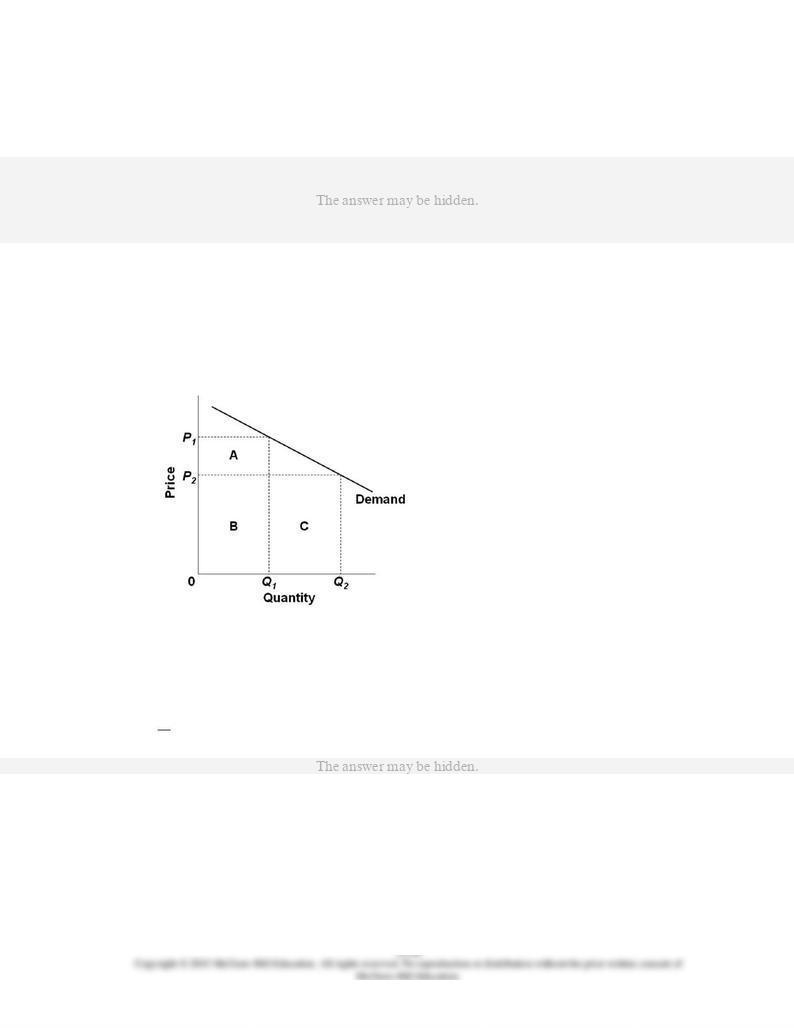
16.
When a firm is on the inelastic segment of its demand curve, it can:
AACSB: Reflective Thinking
Accessibility: Keyboard Navigation
Blooms: Understand
Difficulty: 2 Medium
Learning Objective: 12-03 Explain how demand is seen by a pure monopoly.
Topic: Monopoly demand
17.
Refer to the diagram. If price is reduced from
P
1 to
P
2, total revenue will:
A.
increase by A - C.
B.
increase by C - A.
C.
decrease by A - C.
AACSB: Reflective Thinking
Blooms: Understand
Difficulty: 2 Medium
Learning Objective: 12-03 Explain how demand is seen by a pure monopoly.
Topic: Monopoly demand
Type: Graph

18.
Refer to the diagram. The quantitative difference between areas A and C for reducing the
price from
P
1 to
P
2 measures:
AACSB: Reflective Thinking
Blooms: Understand
Difficulty: 2 Medium
Learning Objective: 12-03 Explain how demand is seen by a pure monopoly.
Topic: Monopoly demand
Type: Graph
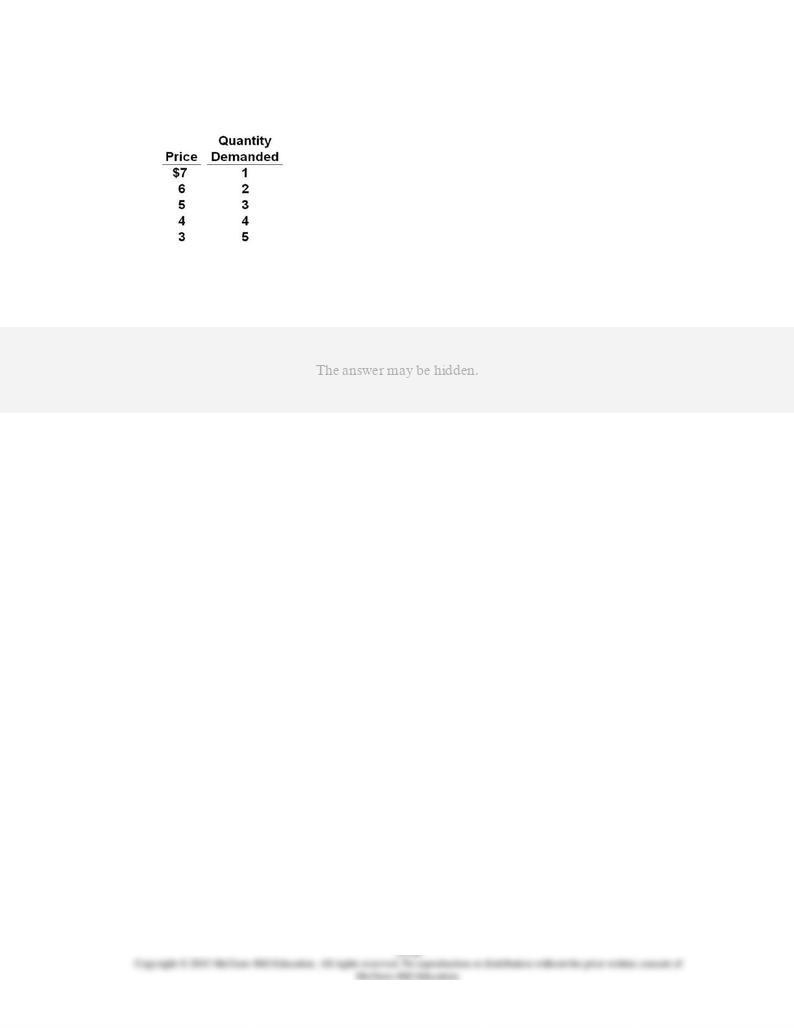
19.
Answer the question on the basis of the demand schedule shown below:
Refer to the data. The marginal revenue obtained from selling the third unit of output is:
AACSB: Analytic
Blooms: Apply
Difficulty: 2 Medium
Learning Objective: 12-03 Explain how demand is seen by a pure monopoly.
Topic: Monopoly demand
Type: Table
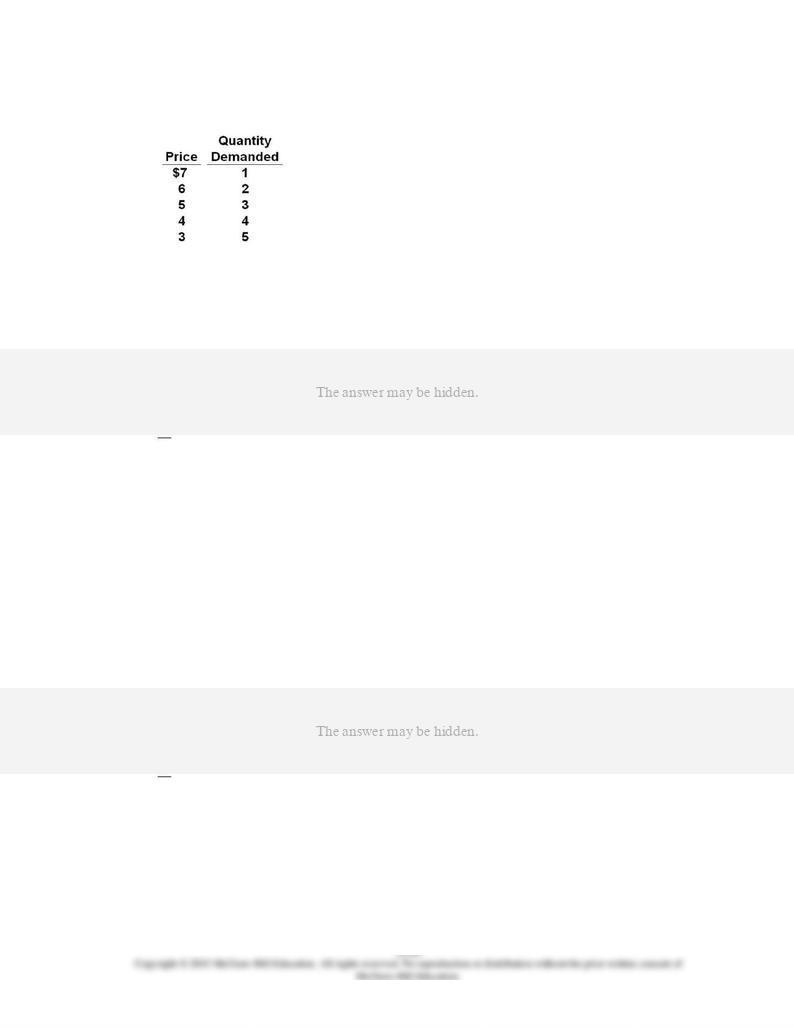
20.
Answer the question on the basis of the demand schedule shown below:
Refer to the data. At the point where 3 units are being sold, the coefficient of price
elasticity of demand:
AACSB: Analytic
Blooms: Apply
Difficulty: 2 Medium
Learning Objective: 12-03 Explain how demand is seen by a pure monopoly.
Topic: Monopoly demand
Type: Table
21.
A monopolistic firm has a sales schedule such that it can sell 10 prefabricated garages per
week at $10,000 each, but if it restricts its output to 9 per week it can sell these at $11,000
each. The marginal revenue of the tenth unit of sales per week is:
AACSB: Analytic
Accessibility: Keyboard Navigation
Blooms: Apply
Difficulty: 2 Medium
Learning Objective: 12-03 Explain how demand is seen by a pure monopoly.
Topic: Monopoly demand
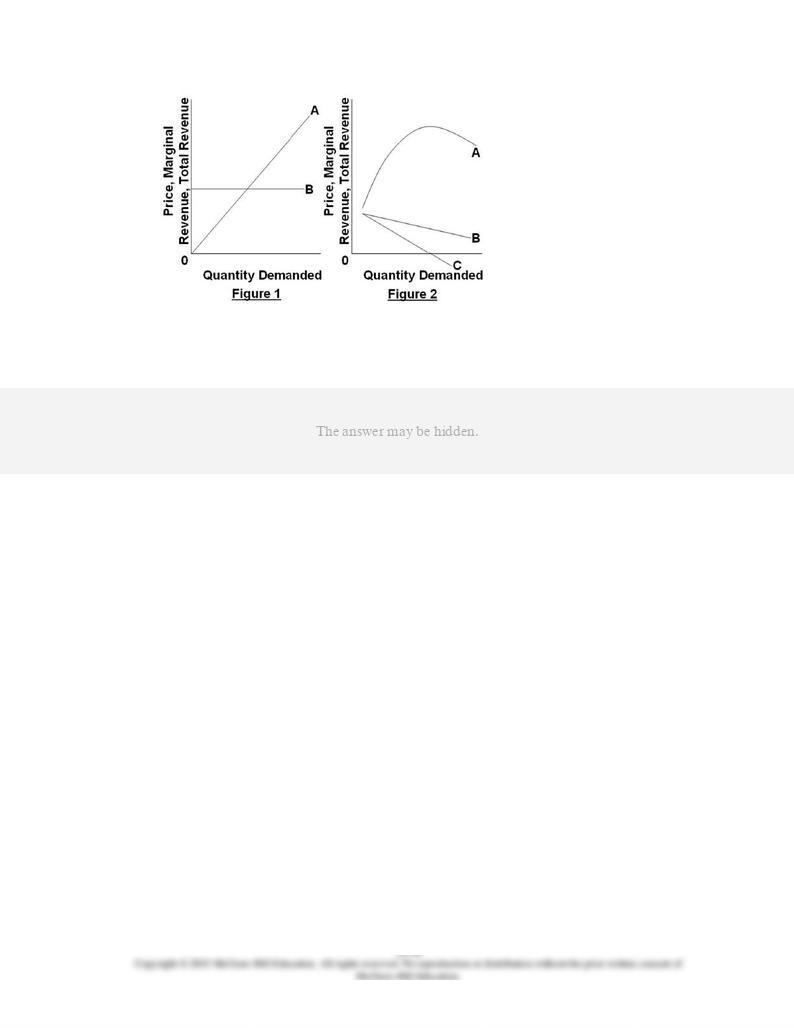
22.
Refer to the two diagrams for individual firms. Figure 1 pertains to:
AACSB: Reflective Thinking
Blooms: Understand
Difficulty: 2 Medium
Learning Objective: 12-03 Explain how demand is seen by a pure monopoly.
Topic: Monopoly demand
Type: Graph
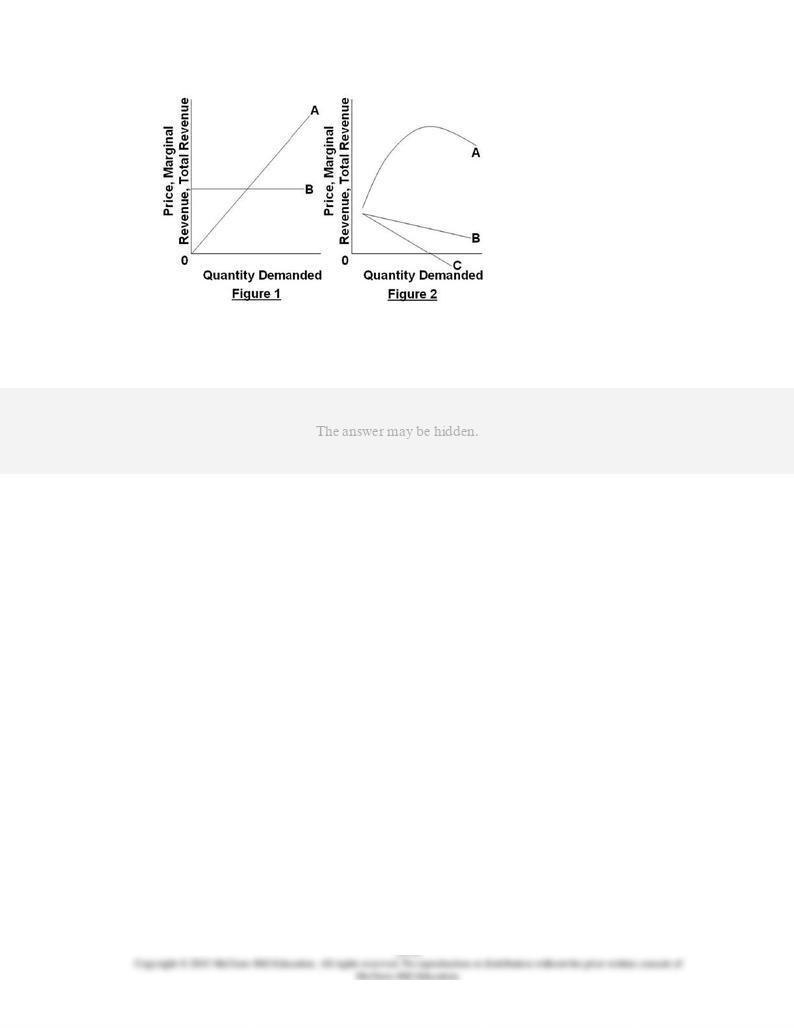
23.
Refer to the two diagrams for individual firms. In Figure 1 line
B
represents the firm's:
AACSB: Reflective Thinking
Blooms: Understand
Difficulty: 2 Medium
Learning Objective: 12-03 Explain how demand is seen by a pure monopoly.
Topic: Monopoly demand
Type: Graph
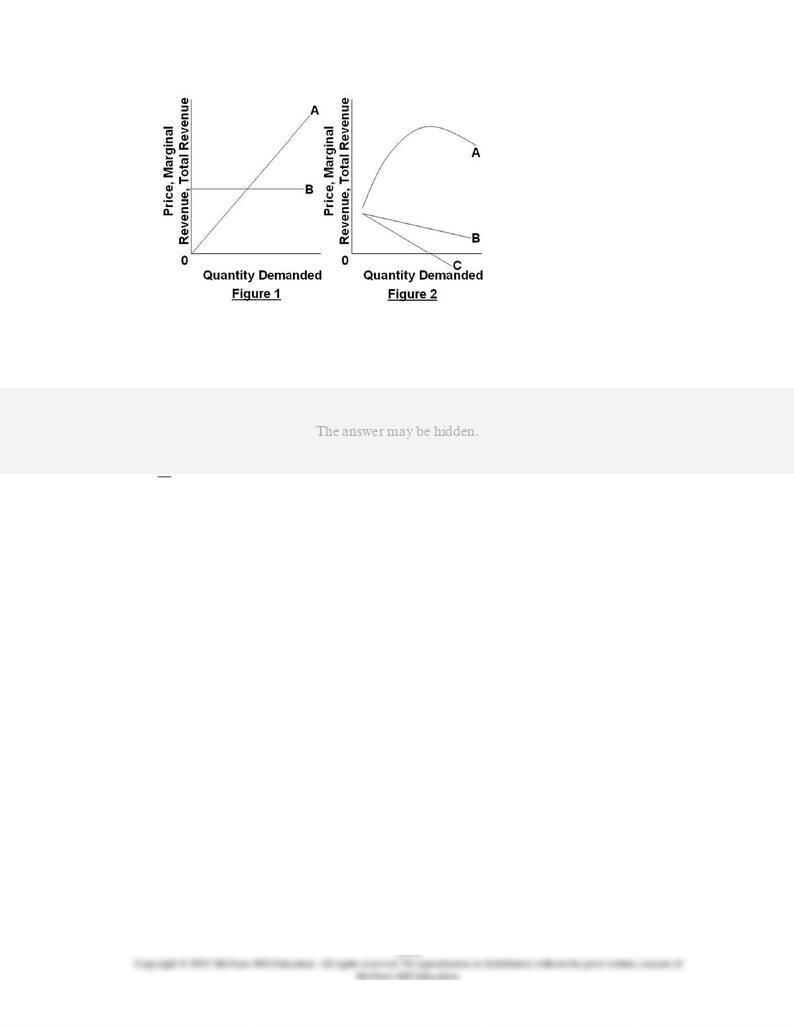
24.
Refer to the two diagrams for individual firms. In Figure 1, line
A
represents the firm's:
AACSB: Reflective Thinking
Blooms: Understand
Difficulty: 2 Medium
Learning Objective: 12-03 Explain how demand is seen by a pure monopoly.
Topic: Monopoly demand
Type: Graph
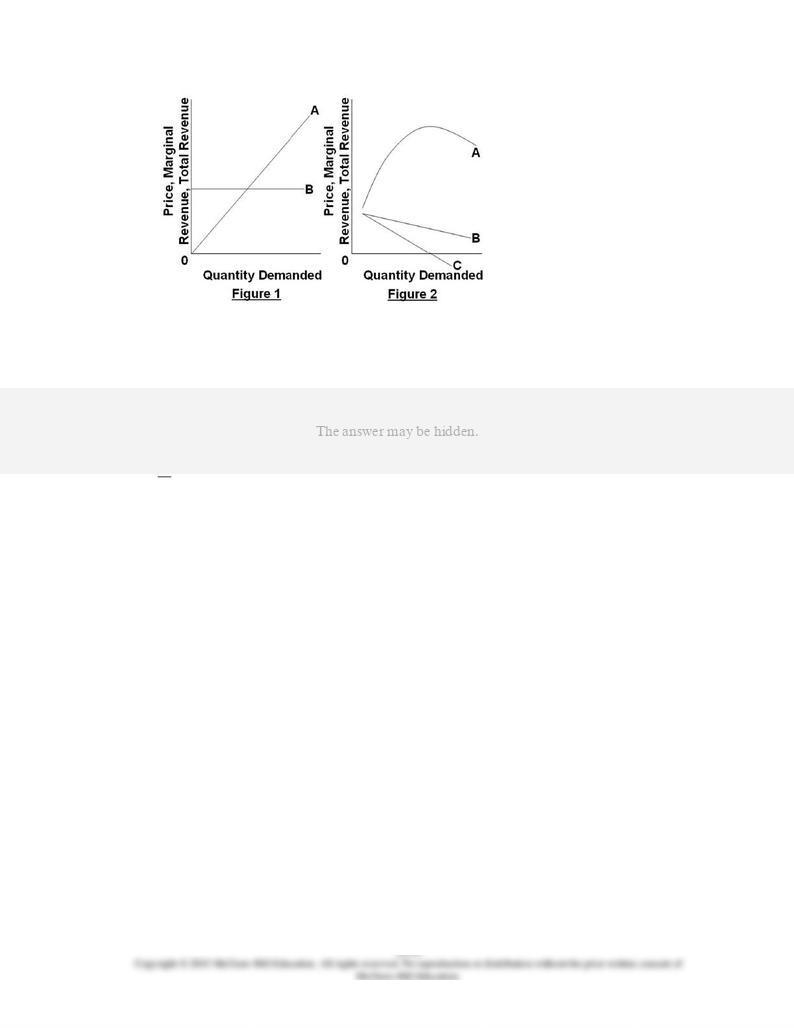
25.
Refer to the two diagrams for individual firms. Figure 2 pertains to:
AACSB: Reflective Thinking
Blooms: Understand
Difficulty: 2 Medium
Learning Objective: 12-03 Explain how demand is seen by a pure monopoly.
Topic: Monopoly demand
Type: Graph
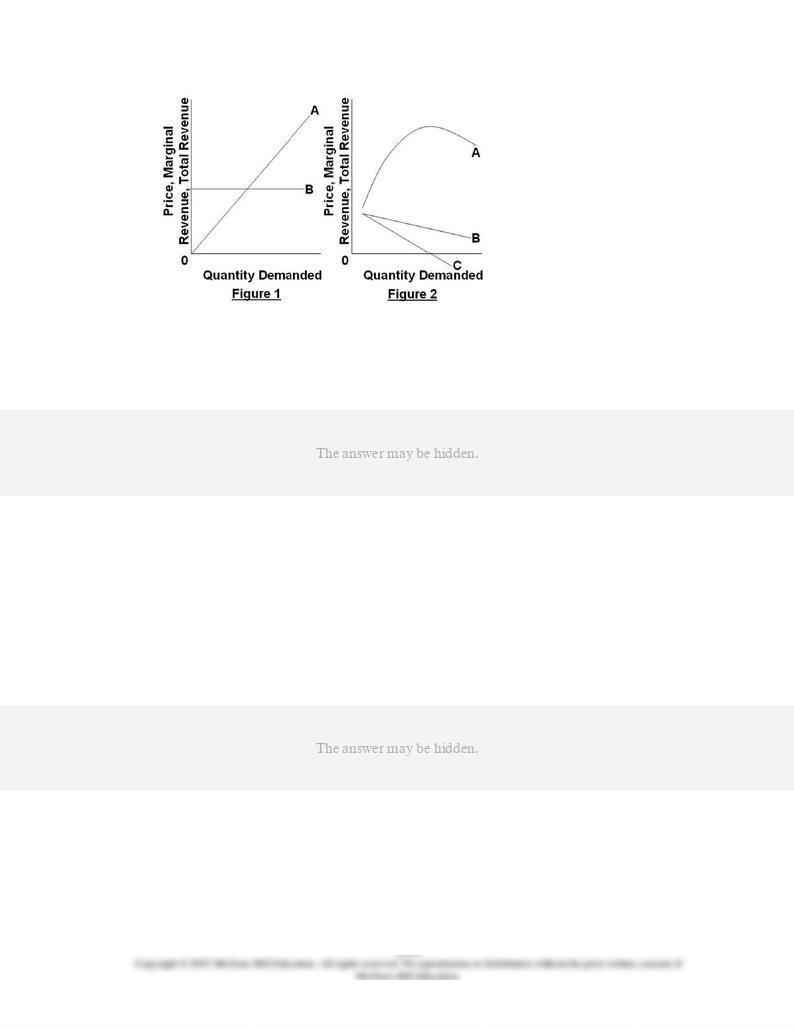
26.
Refer to the two diagrams for individual firms. In Figure 2 the firm's demand and marginal
revenue curves are represented by:
AACSB: Reflective Thinking
Blooms: Understand
Difficulty: 2 Medium
Learning Objective: 12-03 Explain how demand is seen by a pure monopoly.
Topic: Monopoly demand
Type: Graph
27.
With respect to the pure monopolist's demand curve, it can be said that:
AACSB: Reflective Thinking
Accessibility: Keyboard Navigation
Blooms: Understand
Difficulty: 2 Medium
Learning Objective: 12-03 Explain how demand is seen by a pure monopoly.
Topic: Monopoly demand
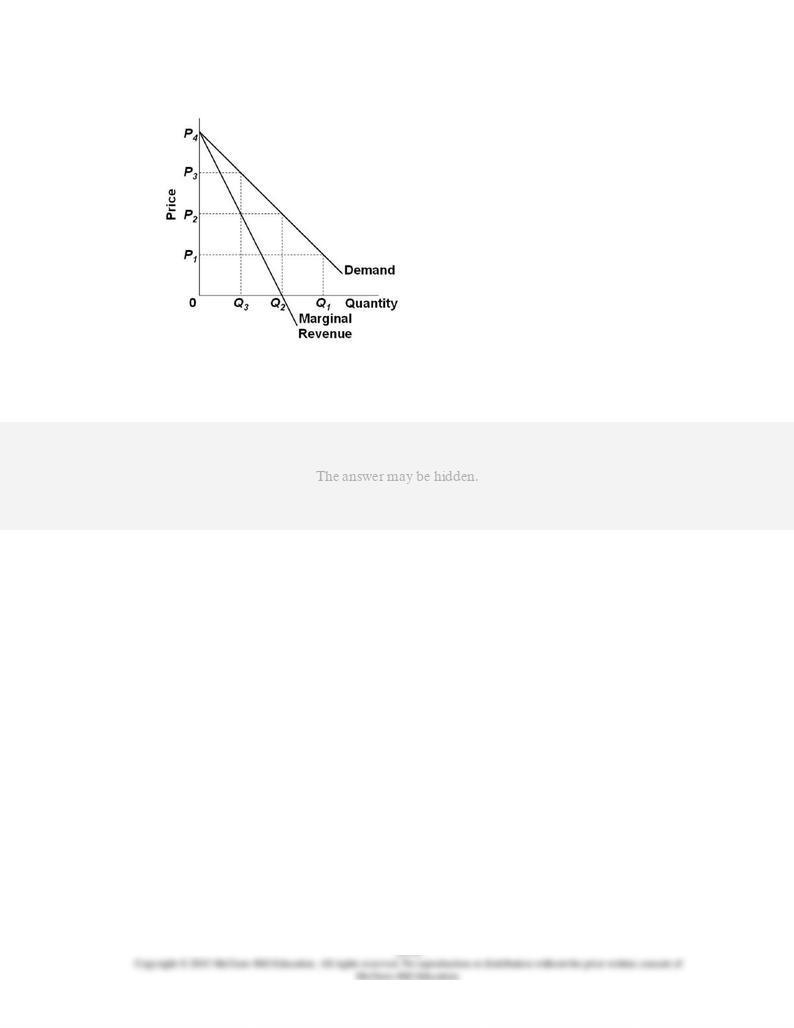
28.
Refer to the diagram. This firm is selling in:
AACSB: Reflective Thinking
Blooms: Understand
Difficulty: 2 Medium
Learning Objective: 12-03 Explain how demand is seen by a pure monopoly.
Topic: Monopoly demand
Type: Graph
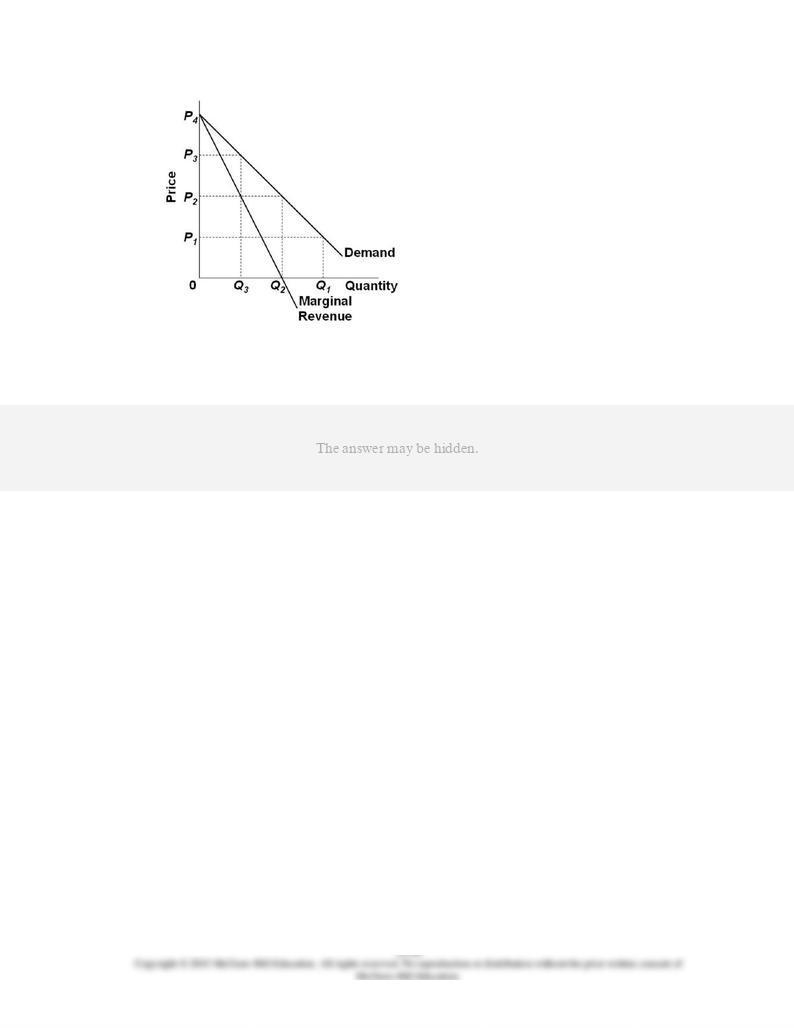
29.
Refer to the diagram. Demand is relatively elastic:
2.
AACSB: Reflective Thinking
Blooms: Understand
Difficulty: 2 Medium
Learning Objective: 12-03 Explain how demand is seen by a pure monopoly.
Topic: Monopoly demand
Type: Graph
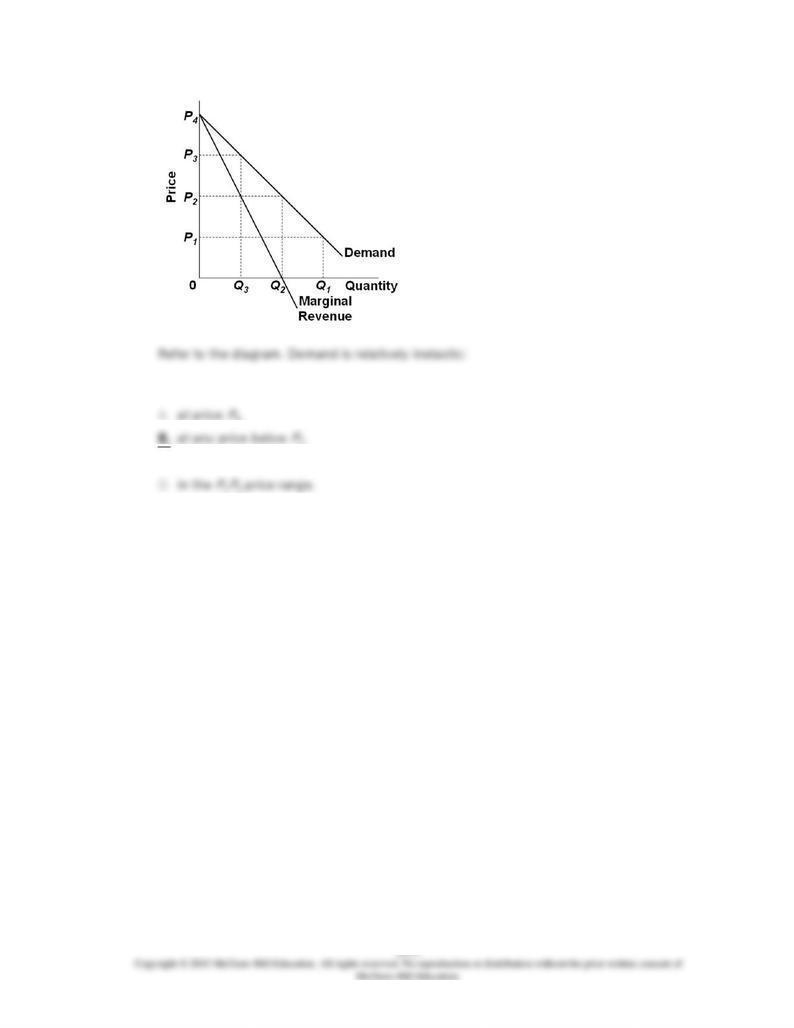
30.
3.
2.
C.
in the
P
2
P
4 price range.
AACSB: Reflective Thinking
Blooms: Understand
Difficulty: 2 Medium
Learning Objective: 12-03 Explain how demand is seen by a pure monopoly.
Topic: Monopoly demand
Type: Graph
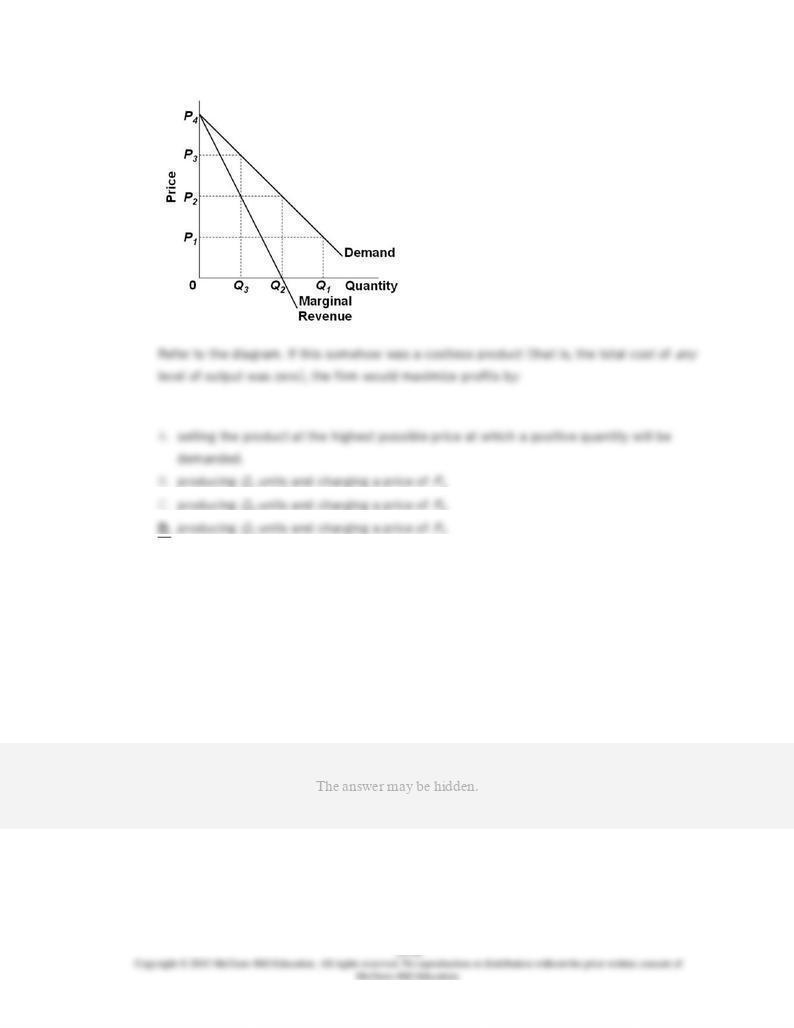
31.
1 units and charging a price of
1.
3 units and charging a price of
3.
2 units and charging a price of
2.
AACSB: Reflective Thinking
Blooms: Analyze
Difficulty: 3 Hard
Learning Objective: 12-04 Explain how a pure monopoly sets its profit-maximizing output and price.
Topic: Output and price determination
Type: Graph
32.
The demand curve faced by a pure monopolist:
AACSB: Reflective Thinking
Accessibility: Keyboard Navigation
Blooms: Understand
Difficulty: 2 Medium

Learning Objective: 12-03 Explain how demand is seen by a pure monopoly.
Topic: Monopoly demand
33.
The marginal revenue curve for a monopolist:
AACSB: Reflective Thinking
Accessibility: Keyboard Navigation
Blooms: Understand
Difficulty: 2 Medium
Learning Objective: 12-03 Explain how demand is seen by a pure monopoly.
Topic: Monopoly demand

34.
If the firm in the diagram lowers price from
P
1 to
P
2, it will:
AACSB: Reflective Thinking
Blooms: Understand
Difficulty: 2 Medium
Learning Objective: 12-03 Explain how demand is seen by a pure monopoly.
Topic: Monopoly demand
Type: Graph
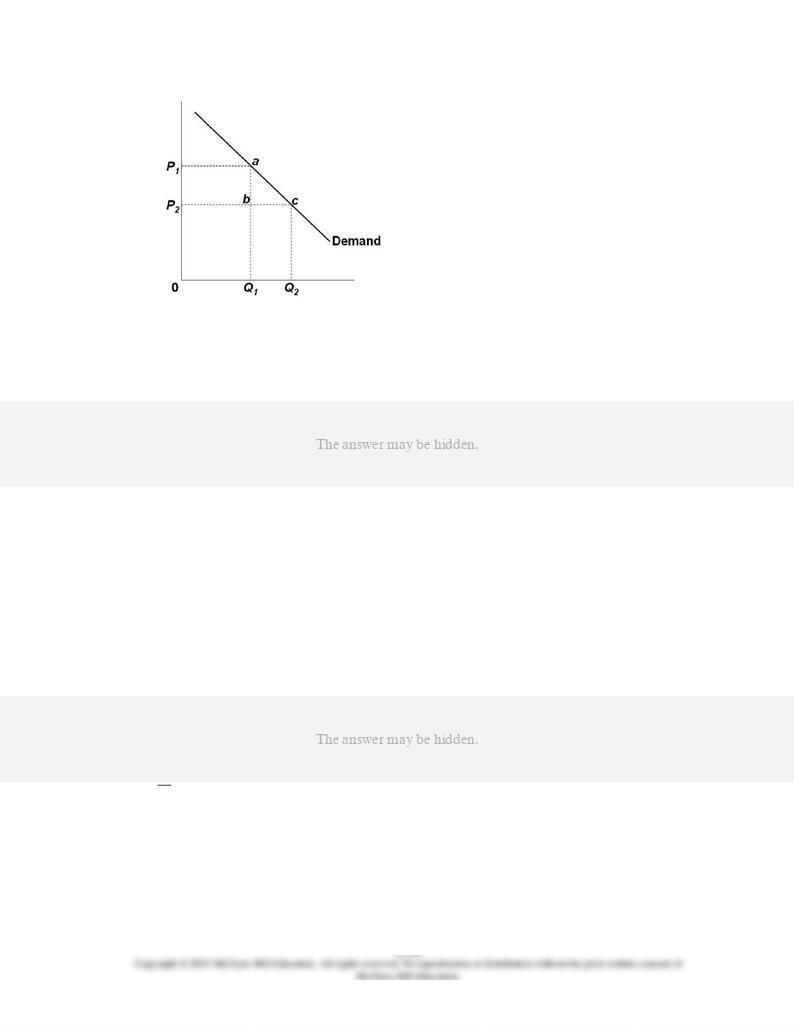
35.
Refer to the diagram. The quantitative difference between areas
Q
1
bcQ
2 and
P
1
P
2
ba
in the
diagram measures:
AACSB: Reflective Thinking
Blooms: Understand
Difficulty: 2 Medium
Learning Objective: 12-03 Explain how demand is seen by a pure monopoly.
Topic: Monopoly demand
Type: Graph
36.
Which of the following is characteristic of a pure monopolist's demand curve?
AACSB: Analytic
Accessibility: Keyboard Navigation
Blooms: Remember
Difficulty: 1 Easy
Learning Objective: 12-03 Explain how demand is seen by a pure monopoly.
Topic: Monopoly demand
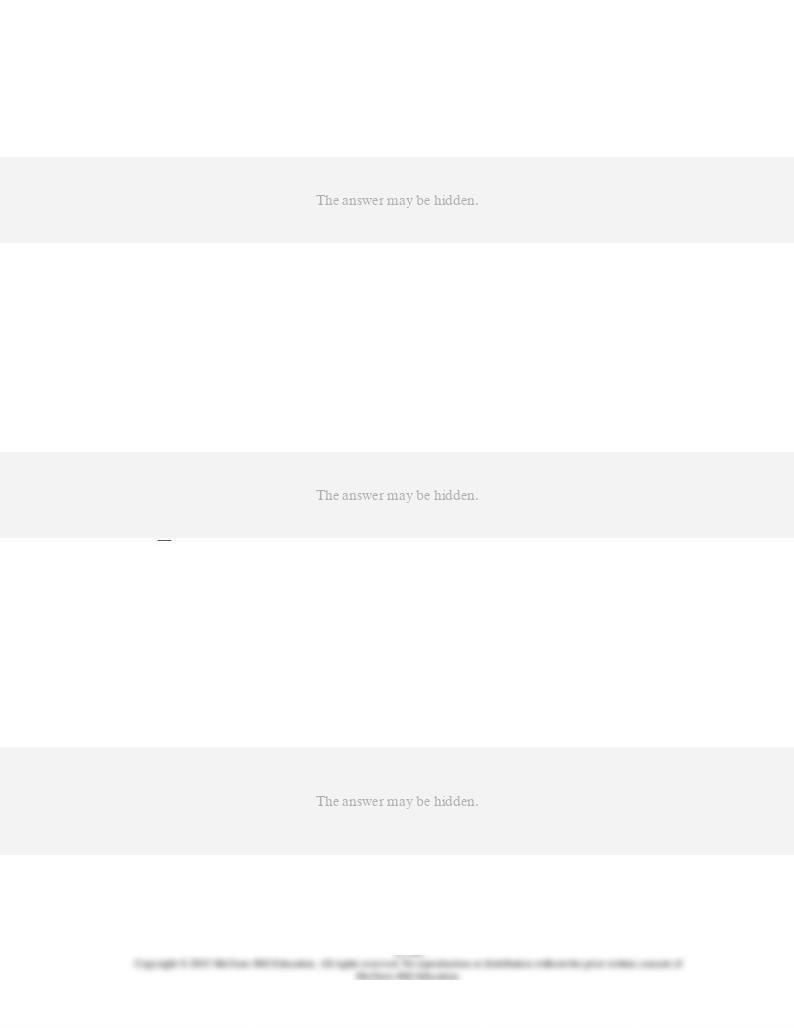
37.
Because the monopolist's demand curve is downsloping:
AACSB: Reflective Thinking
Accessibility: Keyboard Navigation
Blooms: Understand
Difficulty: 2 Medium
Learning Objective: 12-03 Explain how demand is seen by a pure monopoly.
Topic: Monopoly demand
38.
The pure monopolist's demand curve is relatively elastic:
AACSB: Reflective Thinking
Accessibility: Keyboard Navigation
Blooms: Understand
Difficulty: 2 Medium
Learning Objective: 12-03 Explain how demand is seen by a pure monopoly.
Topic: Monopoly demand
39.
A nondiscriminating profit-maximizing monopolist:
AACSB: Reflective Thinking
Accessibility: Keyboard Navigation
Blooms: Understand

Difficulty: 2 Medium
Learning Objective: 12-03 Explain how demand is seen by a pure monopoly.
Topic: Monopoly demand
40.
For a pure monopolist the relationship between total revenue and marginal revenue is
such that:
AACSB: Analytic
Accessibility: Keyboard Navigation
Blooms: Understand
Difficulty: 2 Medium
Learning Objective: 12-03 Explain how demand is seen by a pure monopoly.
Topic: Monopoly demand
41.
For a pure monopolist, marginal revenue is less than price because:
AACSB: Reflective Thinking
Accessibility: Keyboard Navigation
Blooms: Understand
Difficulty: 2 Medium
Learning Objective: 12-03 Explain how demand is seen by a pure monopoly.
Topic: Monopoly demand

42.
4.
2.
2.
AACSB: Reflective Thinking
Blooms: Understand
Difficulty: 2 Medium
Learning Objective: 12-03 Explain how demand is seen by a pure monopoly.
Topic: Monopoly demand
Type: Graph

43.
1.
2.
3.
4.
AACSB: Reflective Thinking
Blooms: Understand
Difficulty: 2 Medium
Learning Objective: 12-03 Explain how demand is seen by a pure monopoly.
Topic: Monopoly demand
Type: Graph
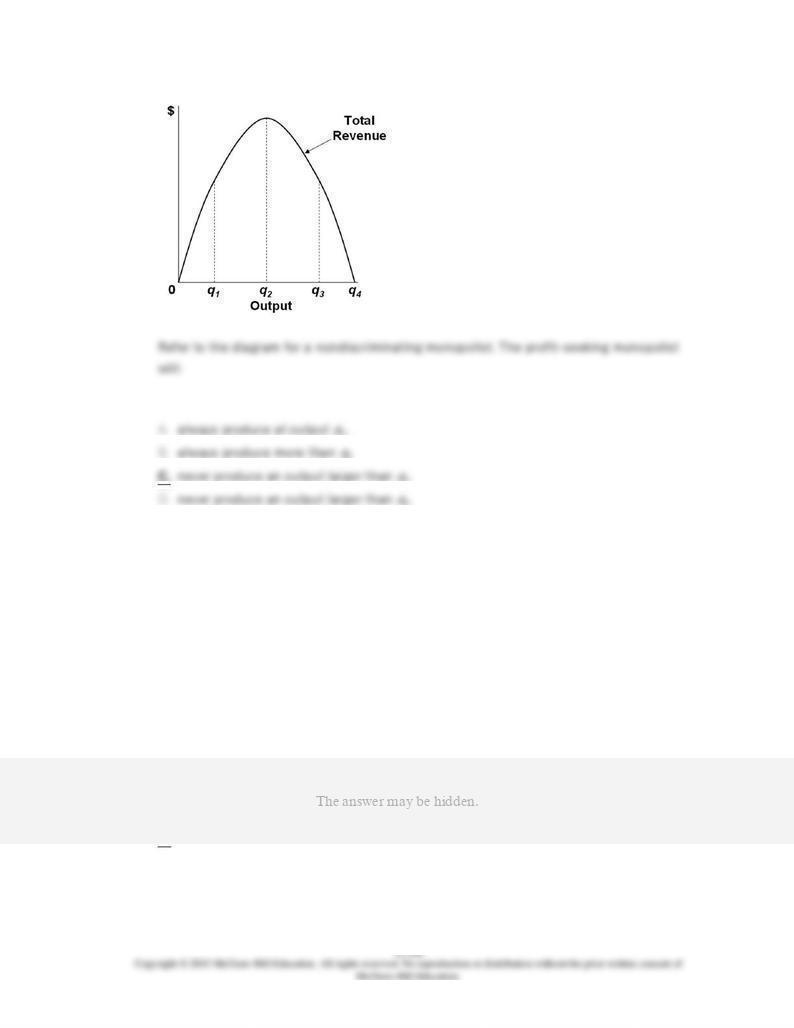
44.
2.
2.
2.
1.
AACSB: Reflective Thinking
Blooms: Analyze
Difficulty: 3 Hard
Learning Objective: 12-03 Explain how demand is seen by a pure monopoly.
Topic: Monopoly demand
Type: Graph
45.
Assume a pure monopolist is currently operating at a price-quantity combination on the
inelastic segment of its demand curve. If the monopolist is seeking maximum profits, it
should:
AACSB: Reflective Thinking
Accessibility: Keyboard Navigation
Blooms: Analyze

Difficulty: 3 Hard
Learning Objective: 12-03 Explain how demand is seen by a pure monopoly.
Topic: Monopoly demand
46.
A pure monopolist should never produce in the:
AACSB: Reflective Thinking
Accessibility: Keyboard Navigation
Blooms: Understand
Difficulty: 2 Medium
Learning Objective: 12-03 Explain how demand is seen by a pure monopoly.
Topic: Monopoly demand
47.
Assuming no change in product demand, a pure monopolist:
AACSB: Reflective Thinking
Accessibility: Keyboard Navigation
Blooms: Understand
Difficulty: 2 Medium
Learning Objective: 12-03 Explain how demand is seen by a pure monopoly.
Topic: Monopoly demand

48.
If a monopolist were to produce in the inelastic segment of its demand curve:
AACSB: Reflective Thinking
Accessibility: Keyboard Navigation
Blooms: Understand
Difficulty: 2 Medium
Learning Objective: 12-03 Explain how demand is seen by a pure monopoly.
Topic: Monopoly demand
49.
If a pure monopolist is operating in a range of output where demand is elastic:
AACSB: Reflective Thinking
Accessibility: Keyboard Navigation
Blooms: Understand
Difficulty: 2 Medium
Learning Objective: 12-03 Explain how demand is seen by a pure monopoly.
Topic: Monopoly demand
50.
Suppose a pure monopolist is charging a price of $12 and the associated marginal revenue
is $9. We thus know that:
AACSB: Analytic
Accessibility: Keyboard Navigation
Blooms: Apply
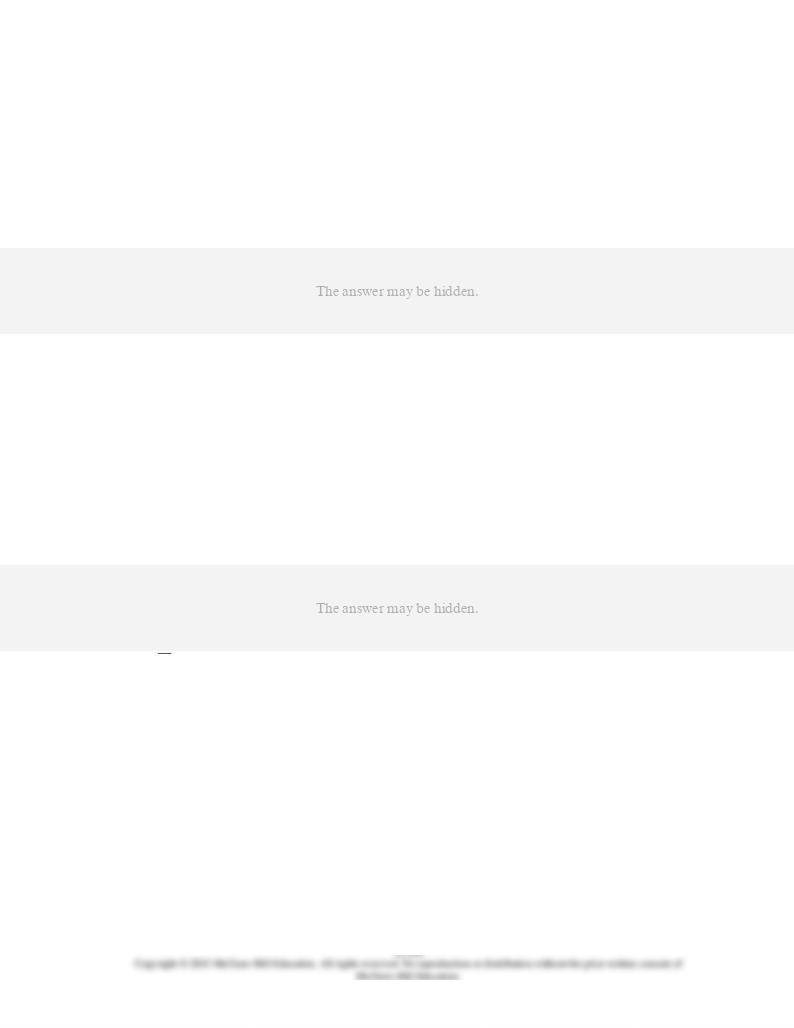
Difficulty: 2 Medium
Learning Objective: 12-03 Explain how demand is seen by a pure monopoly.
Topic: Monopoly demand
51.
A pure monopolist is selling six units at a price of $12. If the marginal revenue of the
seventh unit is $5, then the:
AACSB: Analytic
Accessibility: Keyboard Navigation
Blooms: Apply
Difficulty: 2 Medium
Learning Objective: 12-03 Explain how demand is seen by a pure monopoly.
Topic: Monopoly demand
52.
The vertical distance between the horizontal axis and any point on a nondiscriminating
monopolist's demand curve measures:
AACSB: Reflective Thinking
Accessibility: Keyboard Navigation
Blooms: Understand
Difficulty: 2 Medium
Learning Objective: 12-03 Explain how demand is seen by a pure monopoly.
Topic: Monopoly demand

53.
The diagram indicates that the marginal revenue of the sixth unit of output is:
AACSB: Analytic
Blooms: Apply
Difficulty: 2 Medium
Learning Objective: 12-03 Explain how demand is seen by a pure monopoly.
Topic: Monopoly demand
Type: Graph
54.
Which of the following is
incorrect
? Imperfectly competitive producers:
AACSB: Reflective Thinking
Accessibility: Keyboard Navigation
Blooms: Understand
Difficulty: 2 Medium
Learning Objective: 12-03 Explain how demand is seen by a pure monopoly.
Topic: Monopoly demand

55.
Answer the question on the basis of the following table showing the demand schedule
facing a nondiscriminating monopolist:
Refer to the table. The monopolist will select its profit-maximizing level of output
somewhere within the:
AACSB: Analytic
Blooms: Apply
Difficulty: 2 Medium
Learning Objective: 12-03 Explain how demand is seen by a pure monopoly.
Topic: Monopoly demand
Type: Table
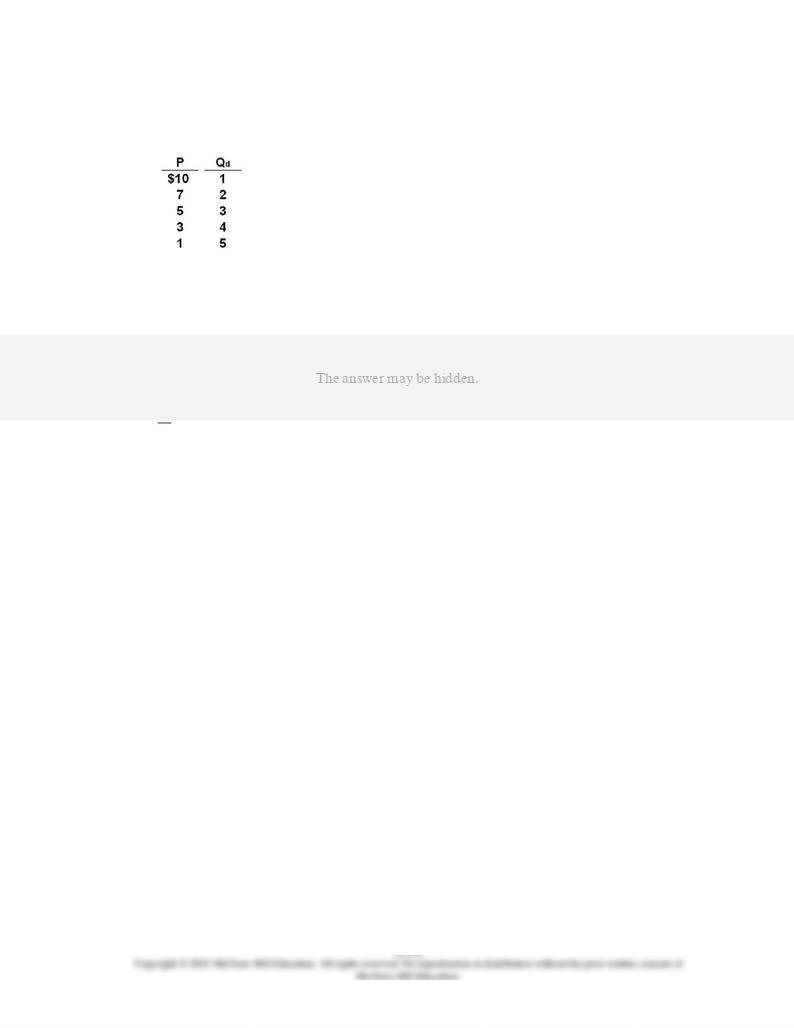
56.
Answer the question on the basis of the following table showing the demand schedule
facing a nondiscriminating monopolist:
Refer to the table. The profit-maximizing monopolist will sell at a price:
AACSB: Analytic
Blooms: Analyze
Difficulty: 3 Hard
Learning Objective: 12-04 Explain how a pure monopoly sets its profit-maximizing output and price.
Topic: Output and price determination
Type: Table
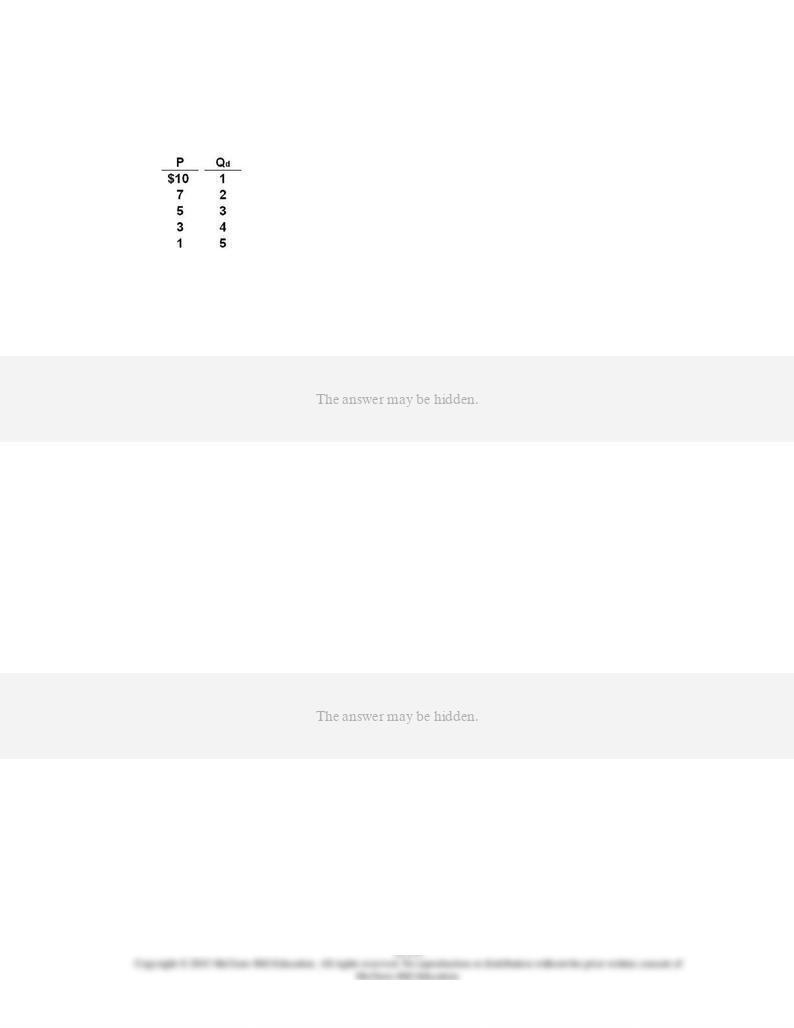
57.
Answer the question on the basis of the following table showing the demand schedule
facing a nondiscriminating monopolist:
Refer to the table. Assume that this monopolist faces zero production costs. The profit-
maximizing monopolist will set a price of:
AACSB: Analytic
Blooms: Analyze
Difficulty: 3 Hard
Learning Objective: 12-04 Explain how a pure monopoly sets its profit-maximizing output and price.
Topic: Output and price determination
Type: Table
58.
A nondiscriminating pure monopolist finds that it can sell its 50th unit of output for $50. We
can surmise that the marginal:
AACSB: Analytic
Accessibility: Keyboard Navigation
Blooms: Apply
Difficulty: 2 Medium
Learning Objective: 12-03 Explain how demand is seen by a pure monopoly.
Topic: Monopoly demand
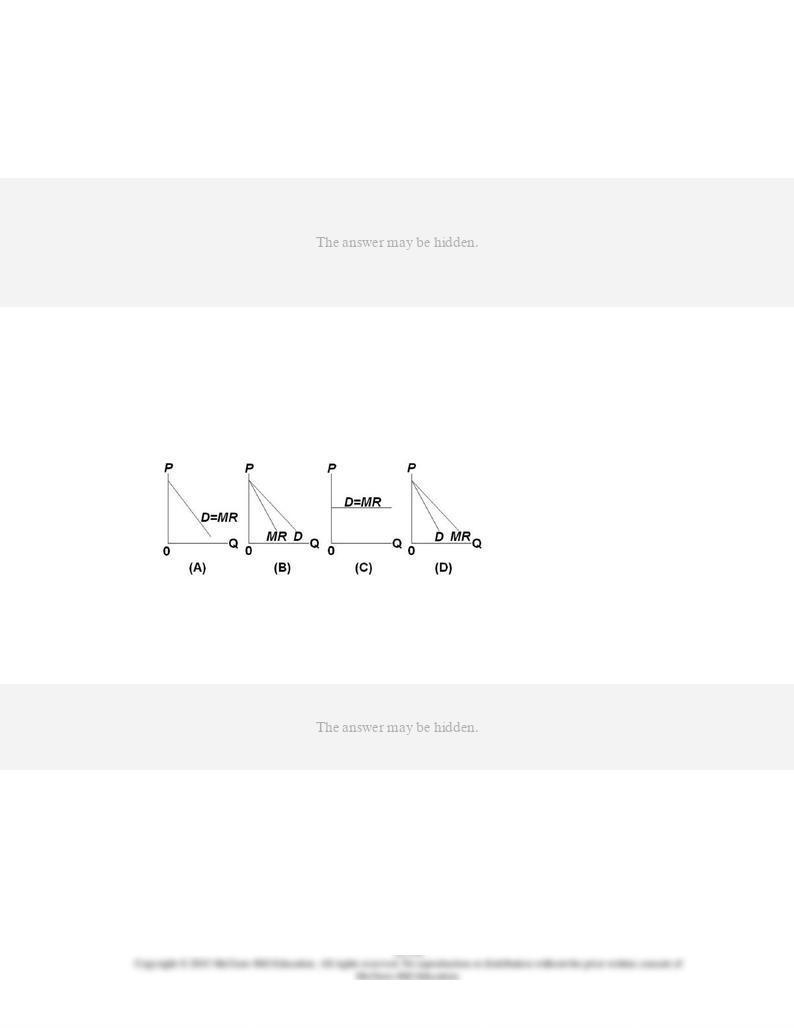
59.
If a nondiscriminating pure monopolist decides to sell one more unit of output, the
marginal revenue associated with that unit will be:
AACSB: Reflective Thinking
Accessibility: Keyboard Navigation
Blooms: Understand
Difficulty: 2 Medium
Learning Objective: 12-03 Explain how demand is seen by a pure monopoly.
Topic: Monopoly demand
60.
Which of the diagrams correctly portrays a nondiscriminating pure monopolist's demand
(
D
) and marginal revenue (MR) curves?
AACSB: Reflective Thinking
Blooms: Understand
Difficulty: 2 Medium
Learning Objective: 12-03 Explain how demand is seen by a pure monopoly.
Topic: Monopoly demand
Type: Graph

61.
Which of the diagrams correctly portrays the demand (
D
) and marginal revenue (MR)
curves of a pure monopolist that is able to price discriminate by charging each customer
his or her maximum willingness to pay?
AACSB: Reflective Thinking
Blooms: Analyze
Difficulty: 3 Hard
Learning Objective: 12-03 Explain how demand is seen by a pure monopoly.
Learning Objective: 12-04 Explain how a pure monopoly sets its profit-maximizing output and price.
Learning Objective: 12-06 Describe why a monopolist might prefer to charge different prices in different markets.
Topic: Monopoly demand
Topic: Output and price determination
Topic: Price discrimination
Type: Graph

62.
Which of the diagrams correctly portrays the demand (
D)
and marginal revenue (MR)
curves of a purely competitive seller?
AACSB: Reflective Thinking
Blooms: Understand
Difficulty: 2 Medium
Learning Objective: 12-03 Explain how demand is seen by a pure monopoly.
Topic: Monopoly demand
Type: Graph
63.
Suppose that a pure monopolist can sell 20 units of output at $10 per unit and 21 units at
$9.75 per unit. The marginal revenue of the 21st unit of output is:
AACSB: Analytic
Accessibility: Keyboard Navigation
Blooms: Apply
Difficulty: 2 Medium
Learning Objective: 12-03 Explain how demand is seen by a pure monopoly.
Topic: Monopoly demand
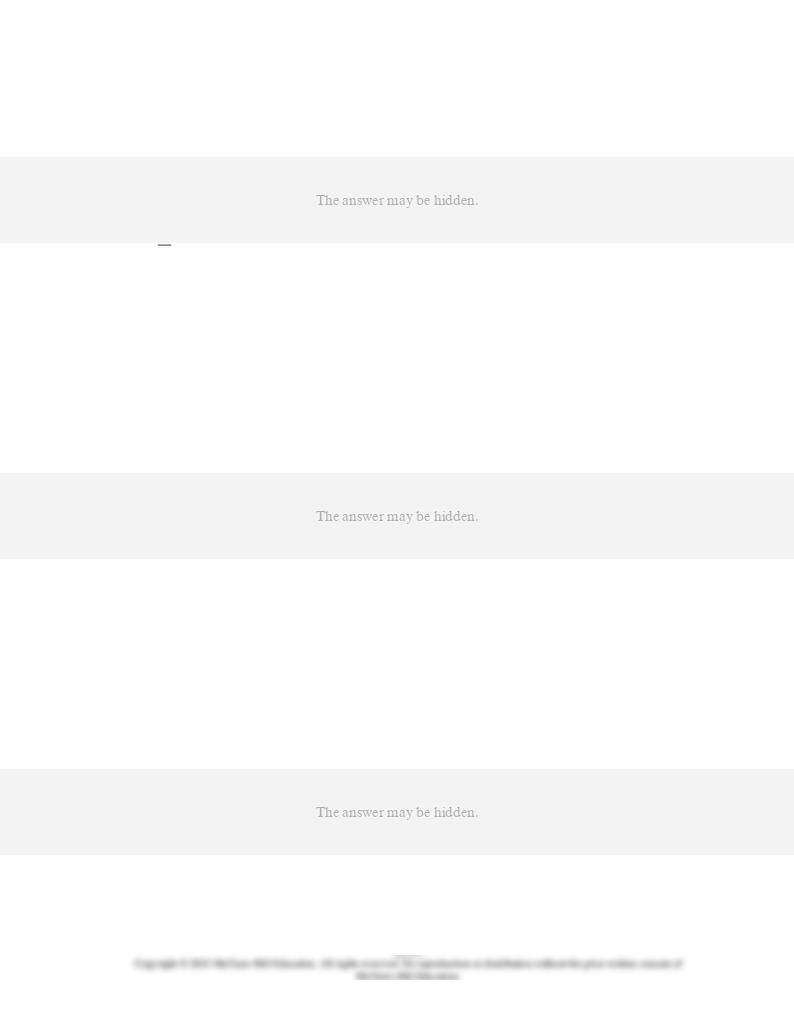
64.
The MR = MC rule:
AACSB: Reflective Thinking
Accessibility: Keyboard Navigation
Blooms: Understand
Difficulty: 2 Medium
Learning Objective: 12-04 Explain how a pure monopoly sets its profit-maximizing output and price.
Topic: Output and price determination
65.
In the long run, a pure monopolist will maximize profits by producing that output at which
marginal cost is equal to:
AACSB: Reflective Thinking
Accessibility: Keyboard Navigation
Blooms: Understand
Difficulty: 2 Medium
Learning Objective: 12-04 Explain how a pure monopoly sets its profit-maximizing output and price.
Topic: Output and price determination
66.
An unregulated pure monopolist will maximize profits by producing that output at which:
AACSB: Reflective Thinking
Accessibility: Keyboard Navigation
Blooms: Understand

Difficulty: 2 Medium
Learning Objective: 12-04 Explain how a pure monopoly sets its profit-maximizing output and price.
Topic: Output and price determination
67.
Suppose that a pure monopolist can sell 5 units of output at $4 per unit and 6 units at
$3.90 per unit. The monopolist will produce and sell the sixth unit if its marginal cost is:
AACSB: Analytic
Accessibility: Keyboard Navigation
Blooms: Analyze
Difficulty: 3 Hard
Learning Objective: 12-04 Explain how a pure monopoly sets its profit-maximizing output and price.
Topic: Output and price determination
68.
Suppose that a pure monopolist can sell 4 units of output at $2 per unit and 5 units at
$1.75 per unit. The monopolist will produce and sell the fifth unit if its marginal cost is:
AACSB: Analytic
Accessibility: Keyboard Navigation
Blooms: Analyze
Difficulty: 3 Hard
Learning Objective: 12-04 Explain how a pure monopoly sets its profit-maximizing output and price.
Topic: Output and price determination
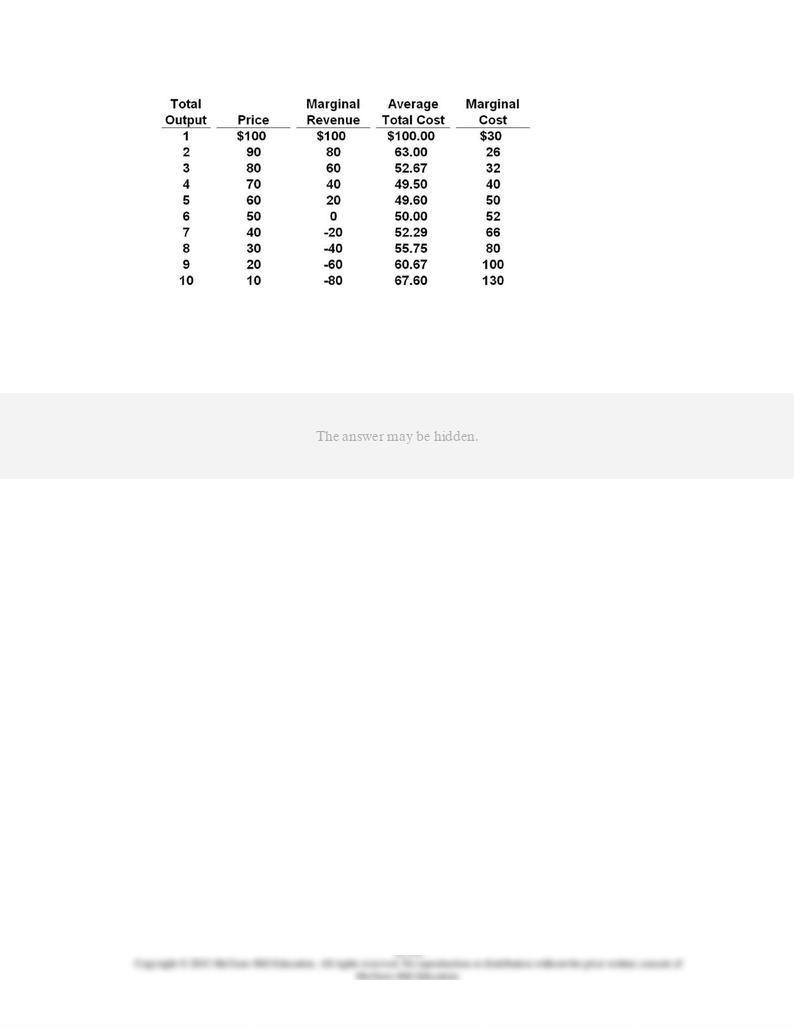
69.
Refer to the data for a nondiscriminating monopolist. This firm will maximize its profit by
producing:
AACSB: Analytic
Blooms: Analyze
Difficulty: 3 Hard
Learning Objective: 12-04 Explain how a pure monopoly sets its profit-maximizing output and price.
Topic: Output and price determination
Type: Table
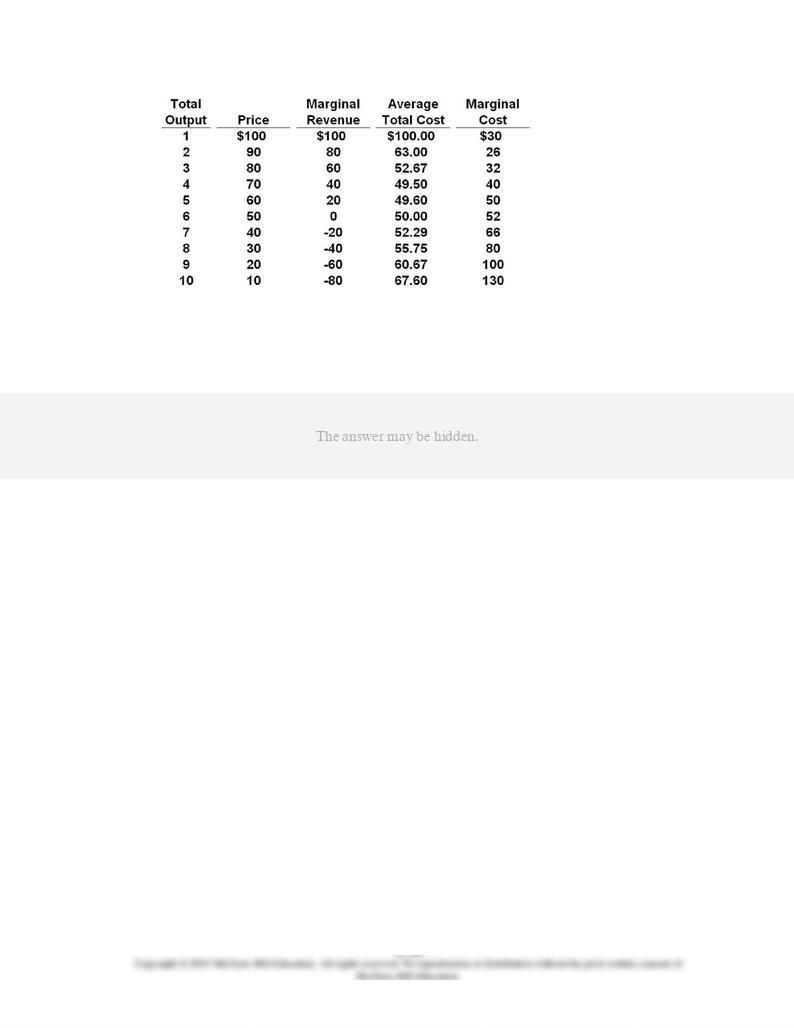
70.
Refer to the data for a nondiscriminating monopolist. At its profit-maximizing output, this
firm will be operating in the:
AACSB: Analytic
Blooms: Evaluate
Difficulty: 3 Hard
Learning Objective: 12-04 Explain how a pure monopoly sets its profit-maximizing output and price.
Topic: Output and price determination
Type: Table

71.
Refer to the data for a nondiscriminating monopolist. At its profit-maximizing output, this
firm's price will exceed its marginal cost by ____ and its average total cost by ____.
AACSB: Analytic
Blooms: Analyze
Difficulty: 3 Hard
Learning Objective: 12-04 Explain how a pure monopoly sets its profit-maximizing output and price.
Topic: Output and price determination
Type: Table
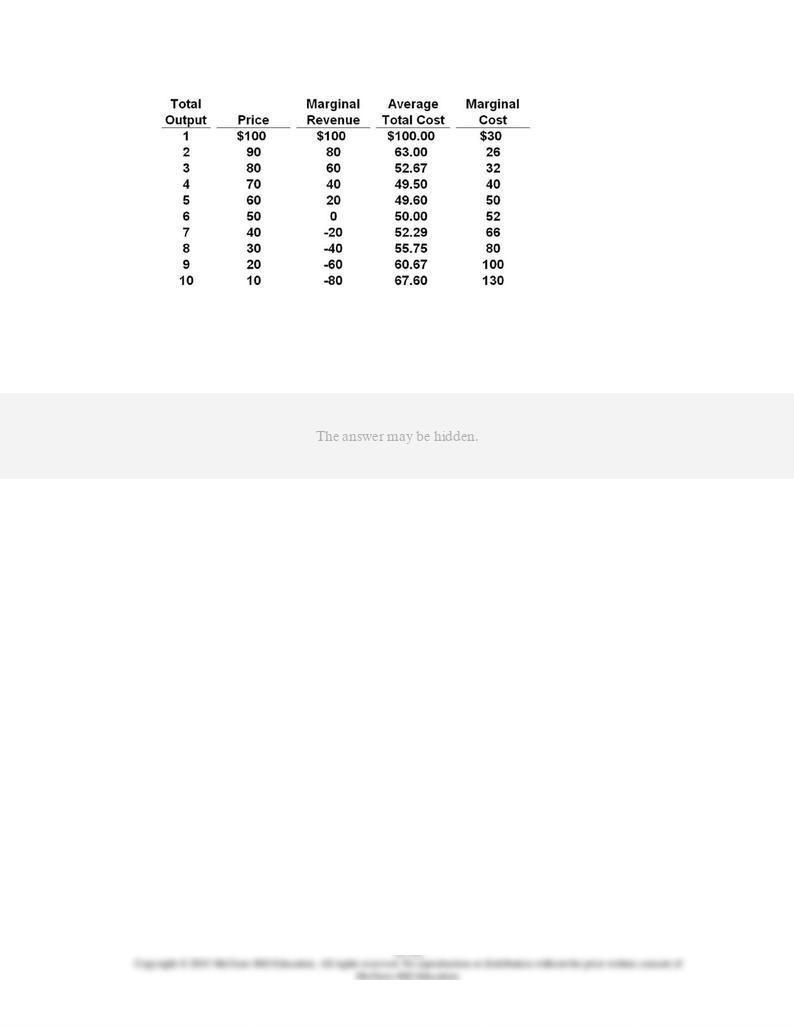
72.
Refer to the data for a nondiscriminating monopolist. At its profit-maximizing output, this
firm's total costs will be:
AACSB: Analytic
Blooms: Analyze
Difficulty: 3 Hard
Learning Objective: 12-04 Explain how a pure monopoly sets its profit-maximizing output and price.
Topic: Output and price determination
Type: Table

73.
Refer to the data. At its profit-maximizing output, this firm's total revenue will be:
AACSB: Analytic
Blooms: Analyze
Difficulty: 3 Hard
Learning Objective: 12-04 Explain how a pure monopoly sets its profit-maximizing output and price.
Topic: Output and price determination
Type: Table
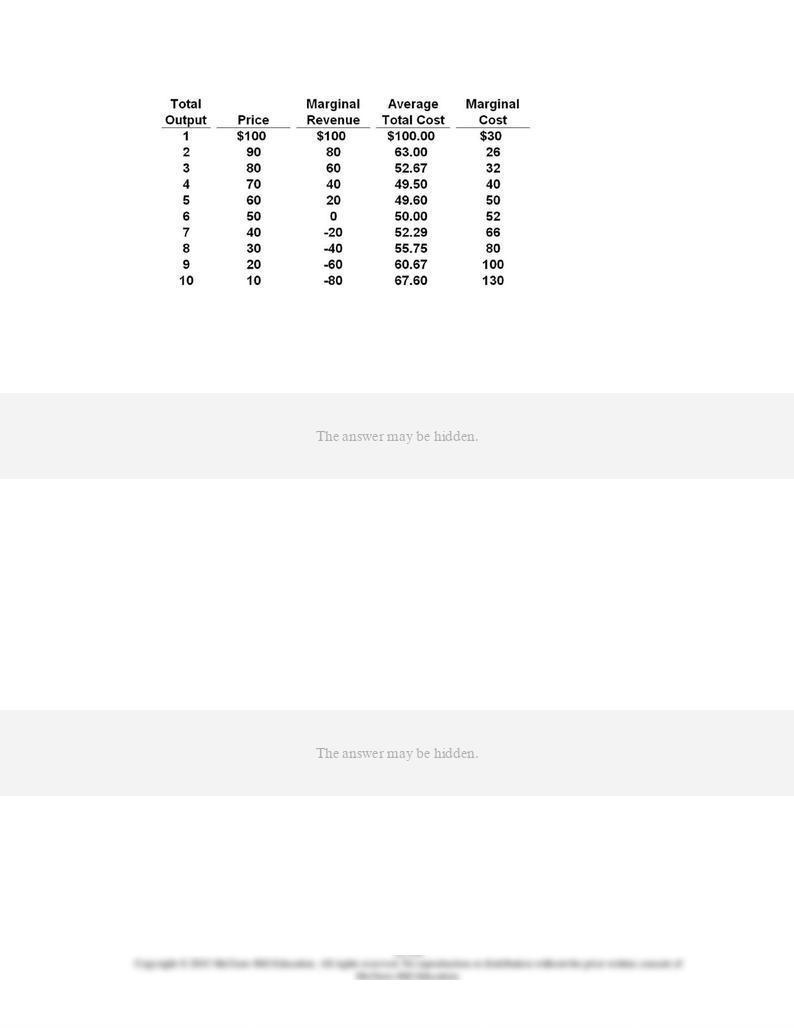
74.
Refer to the data for a nondiscriminating monopolist. At its profit-maximizing output, this
firm's total profit will be:
AACSB: Analytic
Blooms: Analyze
Difficulty: 3 Hard
Learning Objective: 12-04 Explain how a pure monopoly sets its profit-maximizing output and price.
Topic: Output and price determination
Type: Table
75.
A pure monopolist is producing an output such that ATC = $4,
P
= $5, MC = $2, and MR =
$3. This firm is realizing:
AACSB: Analytic
Accessibility: Keyboard Navigation
Blooms: Analyze
Difficulty: 3 Hard
Learning Objective: 12-04 Explain how a pure monopoly sets its profit-maximizing output and price.
Topic: Output and price determination

76.
If a monopolist's marginal revenue is $3.00 and its marginal cost is $4.50, it will increase
its profits by:
AACSB: Reflective Thinking
Accessibility: Keyboard Navigation
Blooms: Analyze
Difficulty: 3 Hard
Learning Objective: 12-04 Explain how a pure monopoly sets its profit-maximizing output and price.
Topic: Output and price determination
77.
Answer the question on the basis of the following demand and cost data for a pure
monopolist:
Refer to the data. The profit-maximizing price for the monopolist will be:
AACSB: Analytic
Blooms: Analyze
Difficulty: 3 Hard
Learning Objective: 12-04 Explain how a pure monopoly sets its profit-maximizing output and price.
Topic: Output and price determination
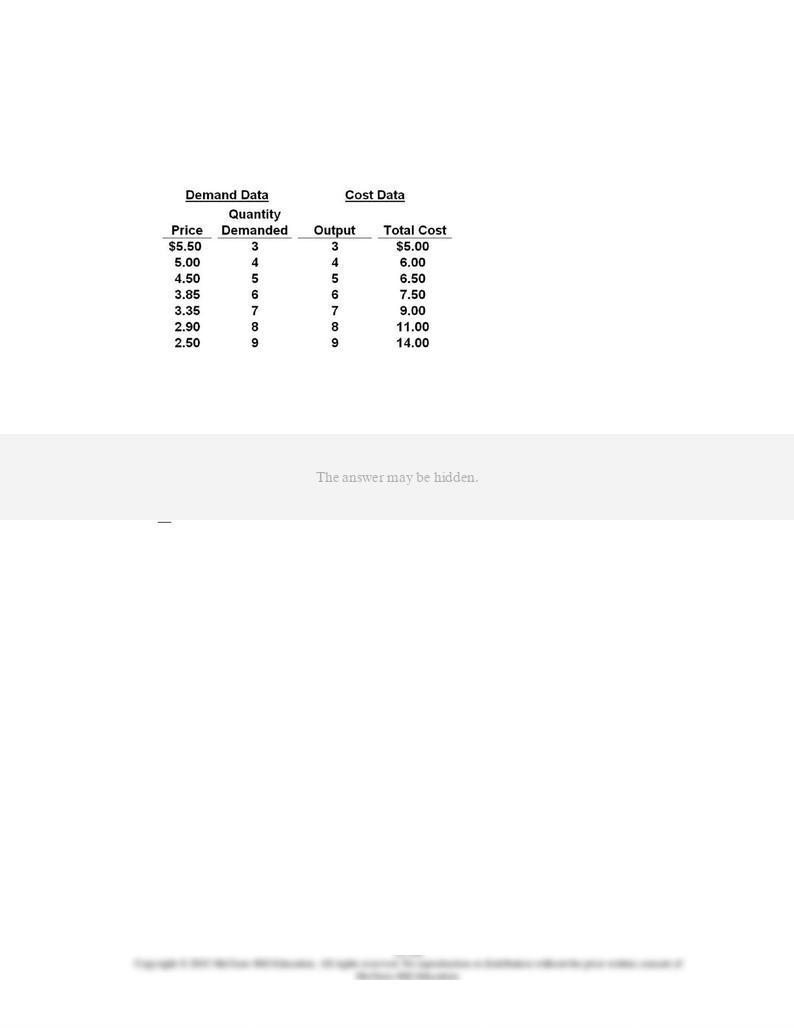
Type: Table
78.
Answer the question on the basis of the following demand and cost data for a pure
monopolist:
Refer to the data. The profit-maximizing level of output will be:
AACSB: Analytic
Blooms: Analyze
Difficulty: 3 Hard
Learning Objective: 12-04 Explain how a pure monopoly sets its profit-maximizing output and price.
Topic: Output and price determination
Type: Table

79.
Answer the question on the basis of the following demand and cost data for a pure
monopolist:
Refer to the data. The profit-maximizing monopolist will realize a:
AACSB: Analytic
Blooms: Analyze
Difficulty: 3 Hard
Learning Objective: 12-04 Explain how a pure monopoly sets its profit-maximizing output and price.
Topic: Output and price determination
Type: Table
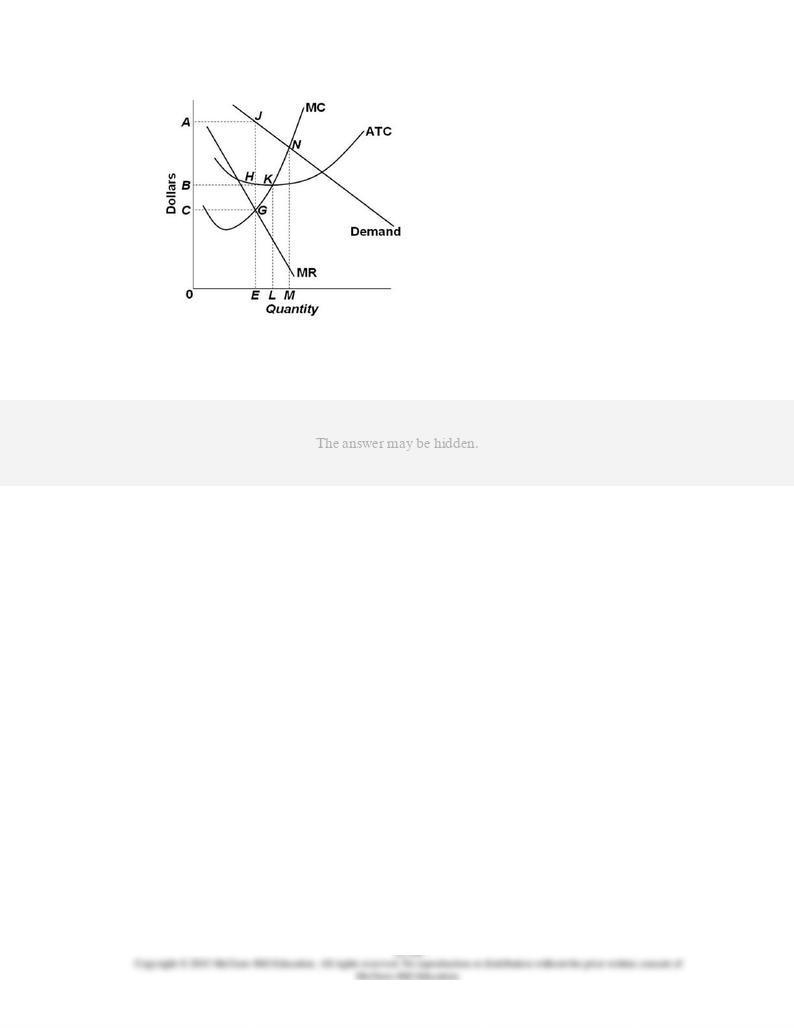
80.
Refer to the diagram. To maximize profits or minimize losses, this firm should produce:
AACSB: Analytic
Blooms: Analyze
Difficulty: 3 Hard
Learning Objective: 12-04 Explain how a pure monopoly sets its profit-maximizing output and price.
Topic: Output and price determination
Type: Graph

81.
Refer to the diagram. At the profit-maximizing level of output, total revenue will be:
AACSB: Analytic
Blooms: Analyze
Difficulty: 3 Hard
Learning Objective: 12-04 Explain how a pure monopoly sets its profit-maximizing output and price.
Topic: Output and price determination
Type: Graph
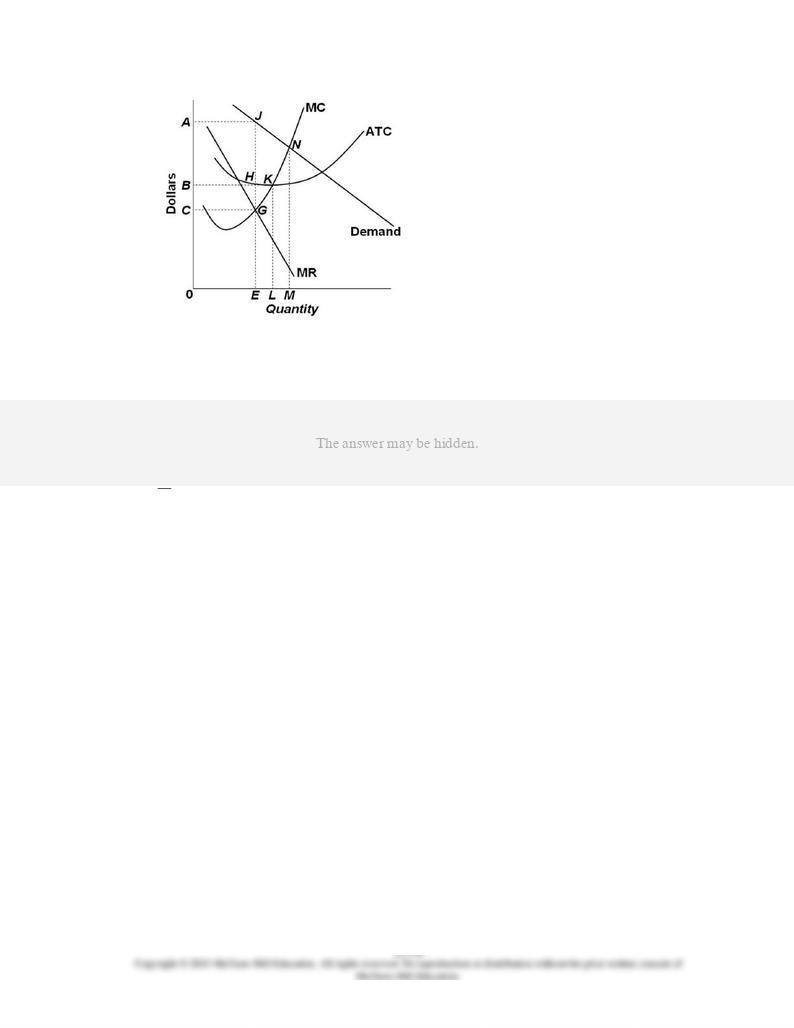
82.
Refer to the diagram. At the profit-maximizing level of output, total cost will be:
AACSB: Analytic
Blooms: Analyze
Difficulty: 3 Hard
Learning Objective: 12-04 Explain how a pure monopoly sets its profit-maximizing output and price.
Topic: Output and price determination
Type: Graph

83.
Refer to the diagram. At the profit-maximizing level of output, the firm will realize:
AACSB: Analytic
Blooms: Analyze
Difficulty: 3 Hard
Learning Objective: 12-04 Explain how a pure monopoly sets its profit-maximizing output and price.
Topic: Output and price determination
Type: Graph
84.
If profits are maximized (or losses minimized), which of the following conditions is
common to both unregulated monopoly and pure competition?
AACSB: Reflective Thinking
Accessibility: Keyboard Navigation
Blooms: Understand
Difficulty: 2 Medium
Learning Objective: 12-04 Explain how a pure monopoly sets its profit-maximizing output and price.
Topic: Output and price determination

85.
A pure monopolist:
AACSB: Reflective Thinking
Accessibility: Keyboard Navigation
Blooms: Understand
Difficulty: 2 Medium
Learning Objective: 12-04 Explain how a pure monopoly sets its profit-maximizing output and price.
Topic: Output and price determination
86.
If a pure monopolist is producing at that output where
P
= ATC, then:
AACSB: Reflective Thinking
Accessibility: Keyboard Navigation
Blooms: Understand
Difficulty: 2 Medium
Learning Objective: 12-04 Explain how a pure monopoly sets its profit-maximizing output and price.
Topic: Output and price determination
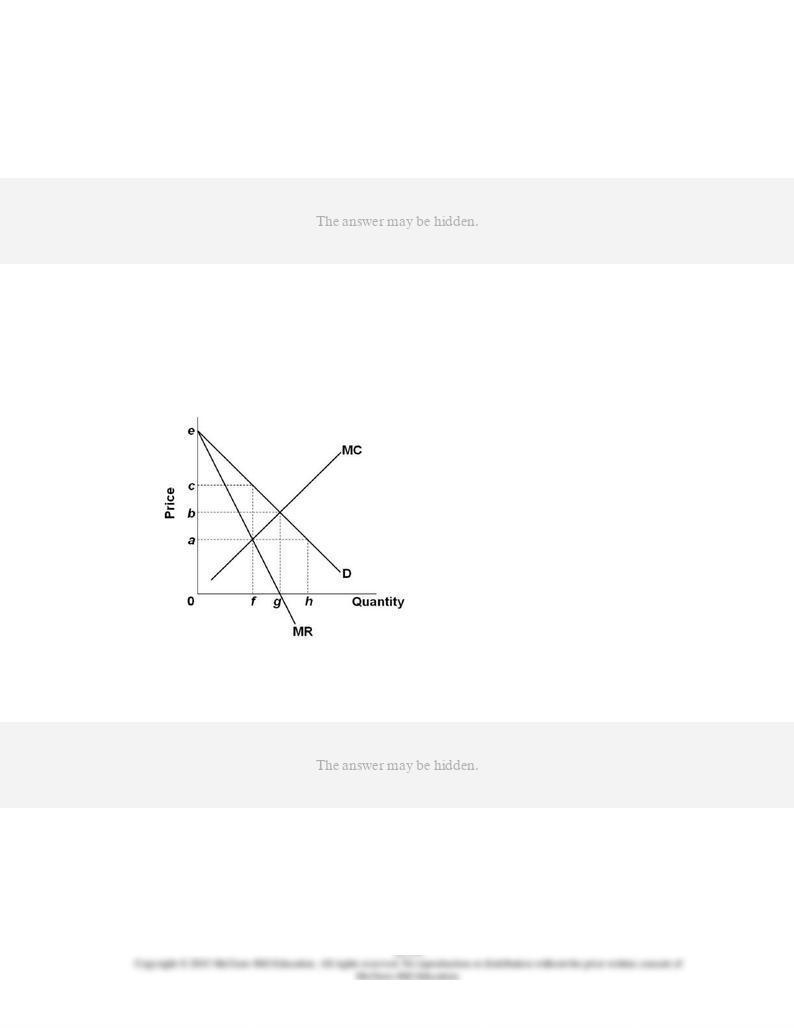
87.
A pure monopolist's short-run profit-maximizing or loss-minimizing position is such that
price:
AACSB: Reflective Thinking
Accessibility: Keyboard Navigation
Blooms: Understand
Difficulty: 2 Medium
Learning Objective: 12-04 Explain how a pure monopoly sets its profit-maximizing output and price.
Topic: Output and price determination
88.
Refer to the diagram for a pure monopolist. Monopoly price will be:
AACSB: Reflective Thinking
Blooms: Analyze
Difficulty: 3 Hard
Learning Objective: 12-04 Explain how a pure monopoly sets its profit-maximizing output and price.
Topic: Output and price determination
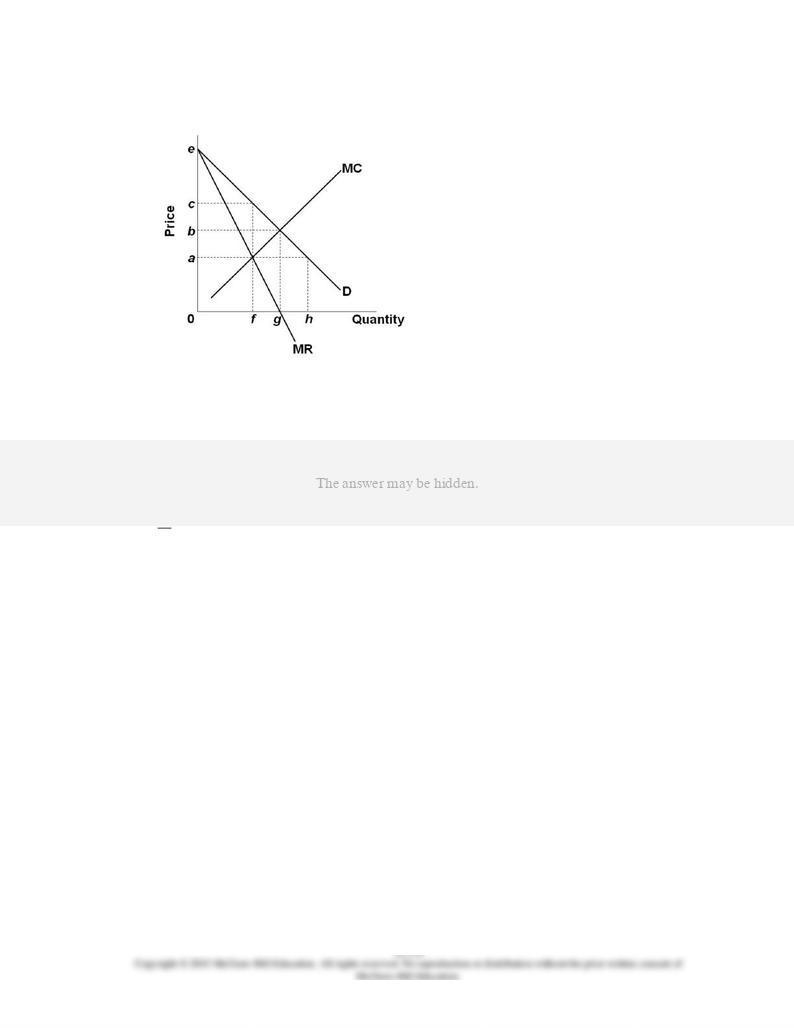
Type: Graph
89.
Refer to the diagram for a pure monopolist. Monopoly output will be:
AACSB: Reflective Thinking
Blooms: Analyze
Difficulty: 3 Hard
Learning Objective: 12-04 Explain how a pure monopoly sets its profit-maximizing output and price.
Topic: Output and price determination
Type: Graph

90.
Refer to the diagram for a pure monopolist. Monopoly profit:
AACSB: Reflective Thinking
Blooms: Analyze
Difficulty: 3 Hard
Learning Objective: 12-04 Explain how a pure monopoly sets its profit-maximizing output and price.
Topic: Output and price determination
Type: Graph
91.
In the short run, a monopolist's economic profits:
AACSB: Reflective Thinking
Accessibility: Keyboard Navigation
Blooms: Understand
Difficulty: 2 Medium
Learning Objective: 12-04 Explain how a pure monopoly sets its profit-maximizing output and price.
Topic: Output and price determination
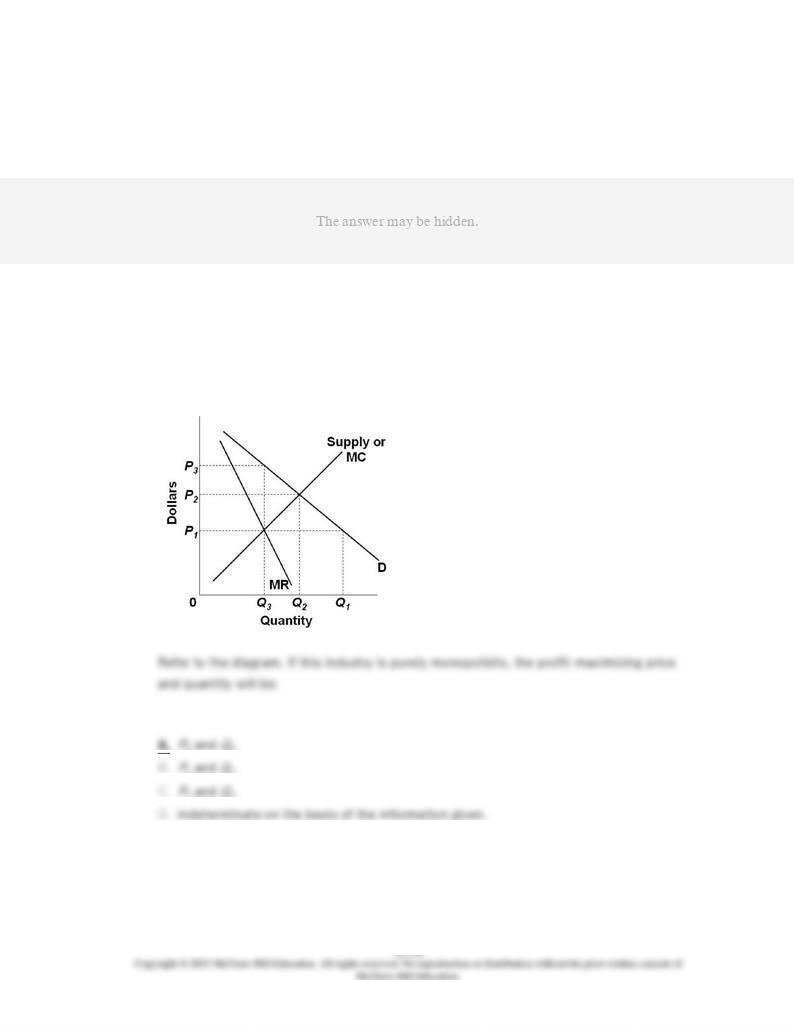
92.
Under which of the following situations would a monopolist increase profits by lowering
price (and increasing output):
AACSB: Reflective Thinking
Accessibility: Keyboard Navigation
Blooms: Apply
Difficulty: 2 Medium
Learning Objective: 12-04 Explain how a pure monopoly sets its profit-maximizing output and price.
Topic: Output and price determination
93.
3 and
3.
1 and
1.
2 and
2.
AACSB: Reflective Thinking
Blooms: Analyze
Difficulty: 3 Hard
Learning Objective: 12-05 Discuss the economic effects of monopoly.
Topic: Economic effects of monopoly
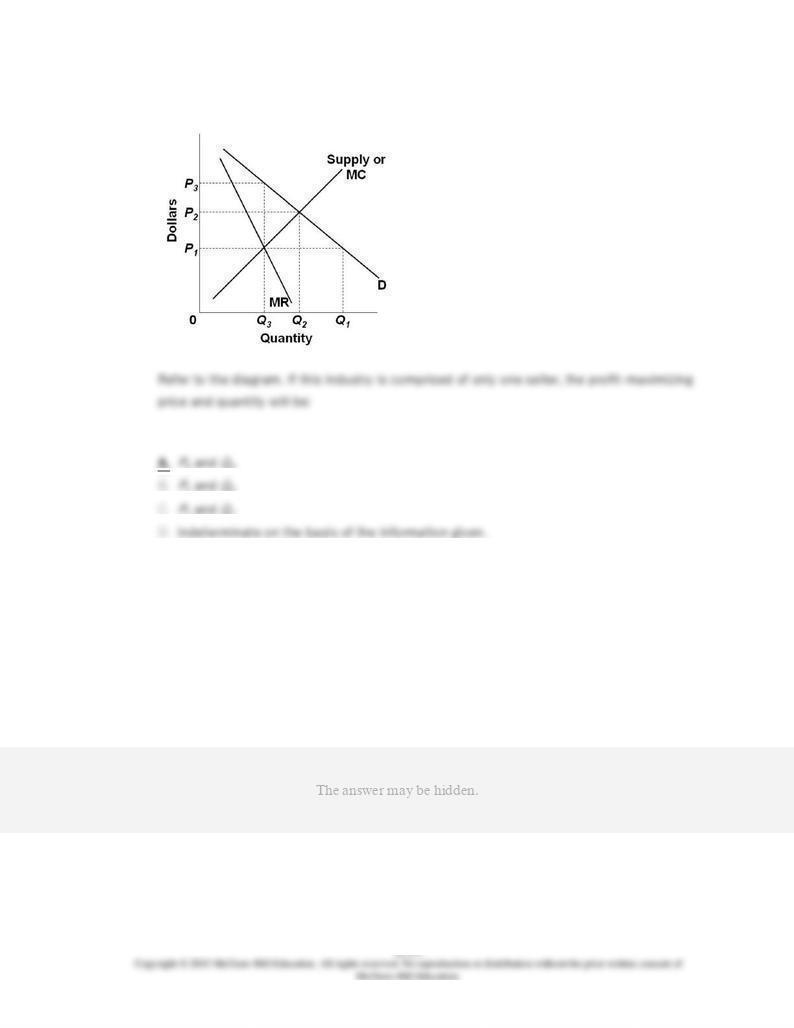
Type: Graph
94.
3 and
3.
1 and
3.
2 and
2.
AACSB: Analytic
Blooms: Analyze
Difficulty: 3 Hard
Learning Objective: 12-04 Explain how a pure monopoly sets its profit-maximizing output and price.
Topic: Output and price determination
Type: Graph
95.
When a pure monopolist is producing its profit-maximizing output, price will:
AACSB: Reflective Thinking
Accessibility: Keyboard Navigation
Blooms: Understand
Difficulty: 2 Medium
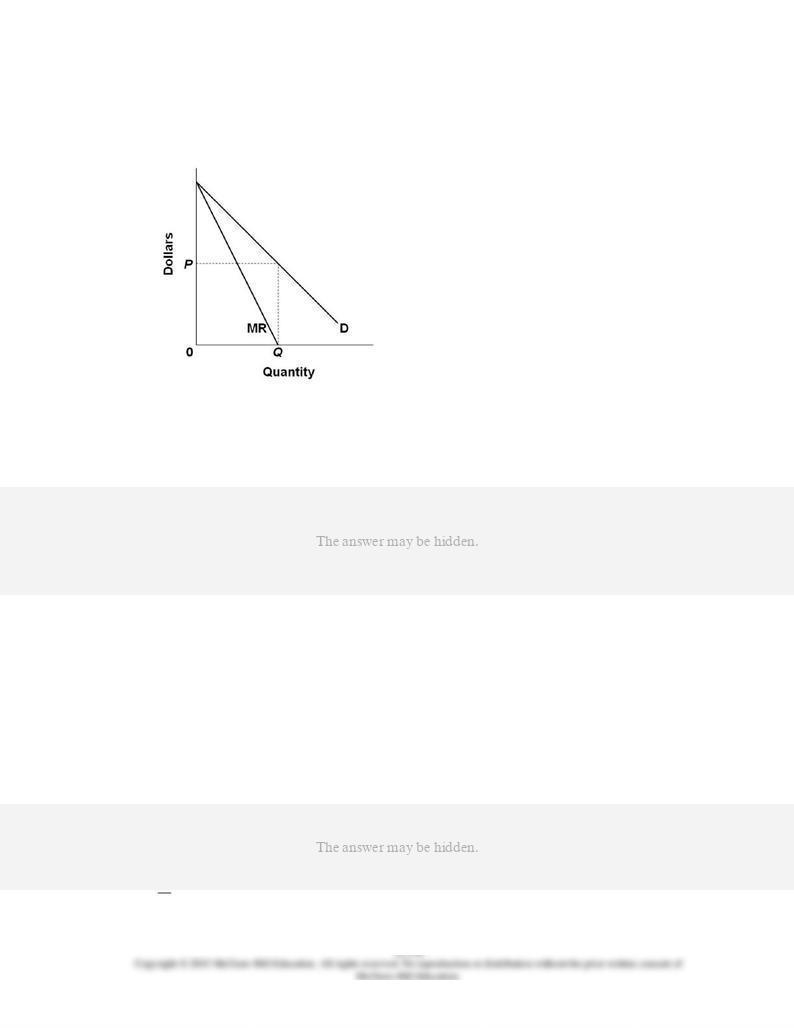
Learning Objective: 12-04 Explain how a pure monopoly sets its profit-maximizing output and price.
Topic: Output and price determination
Type: Graph
96.
Assume a pure monopolist is charging price
P
and selling output
Q
as shown on the
diagram. On the basis of this information, we can say that:
AACSB: Reflective Thinking
Blooms: Analyze
Difficulty: 3 Hard
Learning Objective: 12-04 Explain how a pure monopoly sets its profit-maximizing output and price.
Topic: Output and price determination
Type: Graph
97.
The supply curve for a monopolist is:
AACSB: Reflective Thinking

Accessibility: Keyboard Navigation
Blooms: Understand
Difficulty: 2 Medium
Learning Objective: 12-04 Explain how a pure monopoly sets its profit-maximizing output and price.
Topic: Output and price determination
98.
The supply curve of a pure monopolist:
AACSB: Reflective Thinking
Accessibility: Keyboard Navigation
Blooms: Understand
Difficulty: 2 Medium
Learning Objective: 12-04 Explain how a pure monopoly sets its profit-maximizing output and price.
Topic: Output and price determination
99.
If the variable costs of a profit-maximizing pure monopolist decline, the firm should:
AACSB: Reflective Thinking
Accessibility: Keyboard Navigation
Blooms: Analyze
Difficulty: 3 Hard
Learning Objective: 12-04 Explain how a pure monopoly sets its profit-maximizing output and price.
Topic: Output and price determination
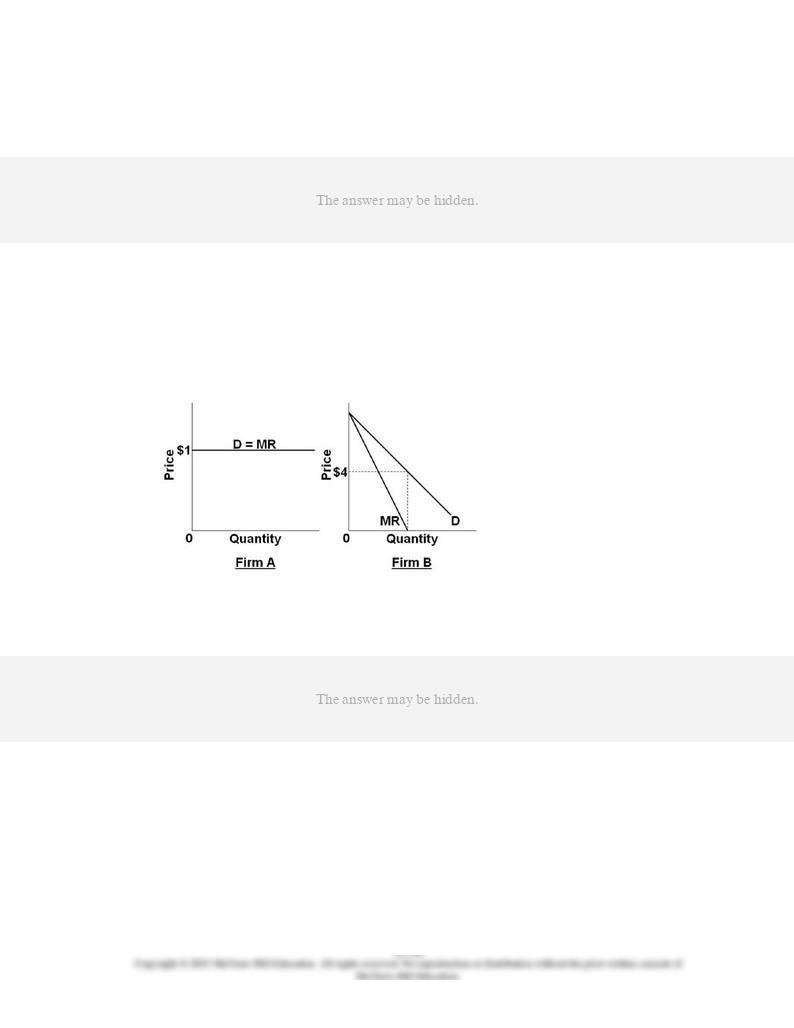
100.
To maximize profit, a pure monopolist must:
AACSB: Reflective Thinking
Accessibility: Keyboard Navigation
Blooms: Understand
Difficulty: 2 Medium
Learning Objective: 12-04 Explain how a pure monopoly sets its profit-maximizing output and price.
Topic: Output and price determination
101.
Refer to the diagrams. Firm A is a:
AACSB: Reflective Thinking
Blooms: Understand
Difficulty: 2 Medium
Learning Objective: 12-05 Discuss the economic effects of monopoly.
Topic: Economic effects of monopoly
Type: Graph
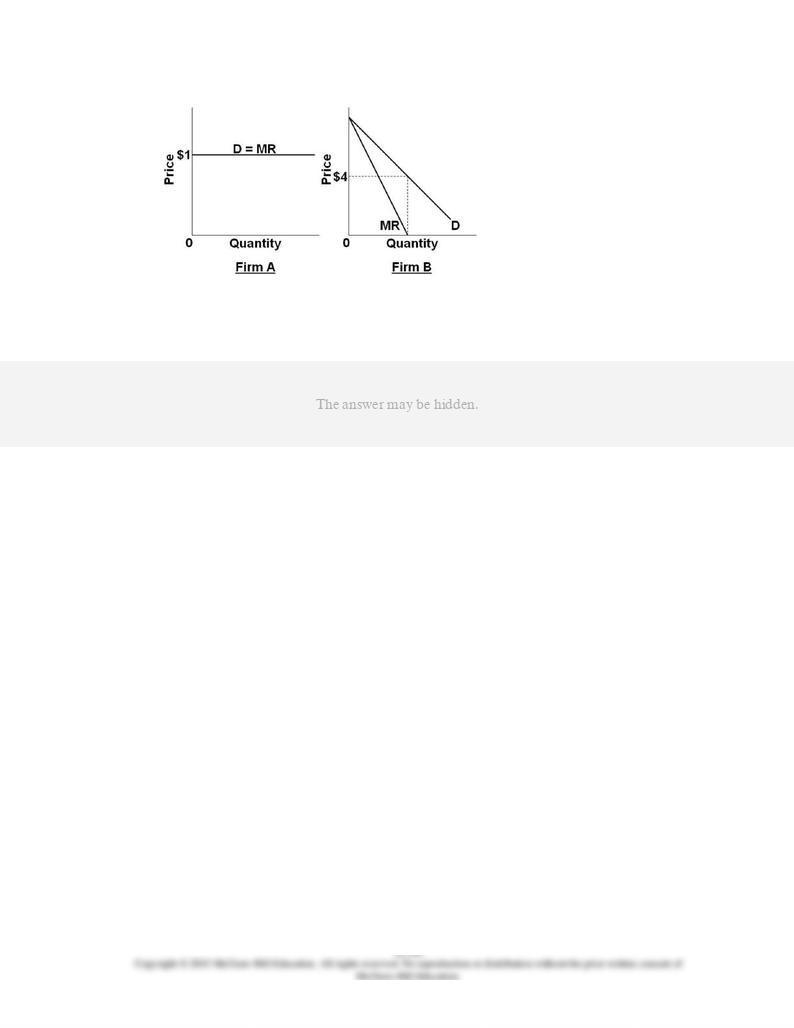
102.
Refer to the diagrams. The demand for Firm A's product is:
AACSB: Reflective Thinking
Blooms: Understand
Difficulty: 2 Medium
Learning Objective: 12-05 Discuss the economic effects of monopoly.
Topic: Economic effects of monopoly
Type: Graph
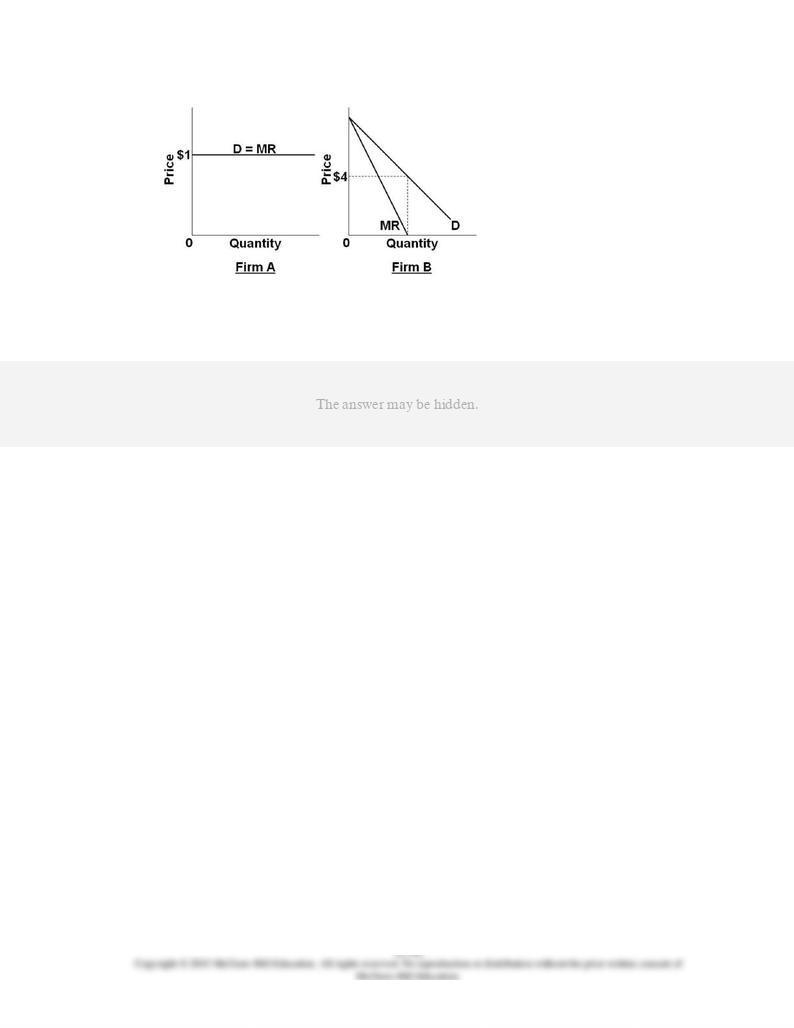
103.
Refer to the diagrams. The demand for Firm B's product is:
AACSB: Reflective Thinking
Blooms: Apply
Difficulty: 2 Medium
Learning Objective: 12-05 Discuss the economic effects of monopoly.
Topic: Economic effects of monopoly
Type: Graph
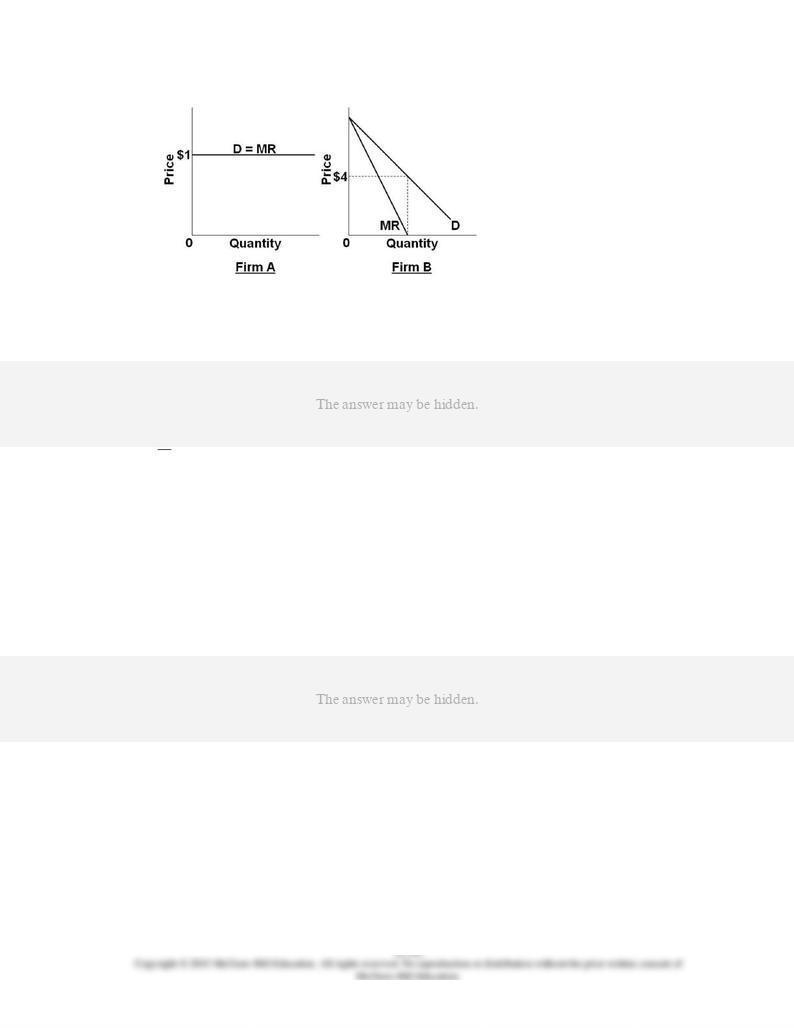
104.
Refer to the diagrams. If $4 is Firm B's profit-maximizing price, its:
AACSB: Analytic
Blooms: Analyze
Difficulty: 3 Hard
Learning Objective: 12-05 Discuss the economic effects of monopoly.
Topic: Economic effects of monopoly
Type: Graph
105.
Economic profit in the long run is:
AACSB: Reflective Thinking
Accessibility: Keyboard Navigation
Blooms: Understand
Difficulty: 2 Medium
Learning Objective: 12-05 Discuss the economic effects of monopoly.
Topic: Economic effects of monopoly

106.
Which of the following statements is
correct
?
AACSB: Reflective Thinking
Accessibility: Keyboard Navigation
Blooms: Understand
Difficulty: 2 Medium
Learning Objective: 12-05 Discuss the economic effects of monopoly.
Topic: Economic effects of monopoly
107.
Confronted with the same unit cost data, a monopolistic producer will charge:
AACSB: Reflective Thinking
Accessibility: Keyboard Navigation
Blooms: Understand
Difficulty: 2 Medium
Learning Objective: 12-05 Discuss the economic effects of monopoly.
Topic: Economic effects of monopoly

108.
An important economic problem associated with pure monopoly is that, at the profit-
maximizing outputs, resources are:
AACSB: Reflective Thinking
Accessibility: Keyboard Navigation
Blooms: Understand
Difficulty: 2 Medium
Learning Objective: 12-05 Discuss the economic effects of monopoly.
Topic: Economic effects of monopoly
109.
A single-price monopoly is economically inefficient because, at the profit-maximizing
output:
AACSB: Reflective Thinking
Accessibility: Keyboard Navigation
Blooms: Understand
Difficulty: 2 Medium
Learning Objective: 12-05 Discuss the economic effects of monopoly.
Topic: Economic effects of monopoly

110.
If a pure monopolist is producing more output than the MR = MC output:
AACSB: Reflective Thinking
Accessibility: Keyboard Navigation
Blooms: Understand
Difficulty: 2 Medium
Learning Objective: 12-05 Discuss the economic effects of monopoly.
Topic: Economic effects of monopoly
111.
At its profit-maximizing output, a pure nondiscriminating monopolist achieves:
AACSB: Reflective Thinking
Accessibility: Keyboard Navigation
Blooms: Understand
Difficulty: 2 Medium
Learning Objective: 12-05 Discuss the economic effects of monopoly.
Topic: Economic effects of monopoly
112.
The profit-maximizing output of a pure monopoly is
not
socially optimal because in
equilibrium:
AACSB: Reflective Thinking
Accessibility: Keyboard Navigation
Blooms: Understand

Difficulty: 2 Medium
Learning Objective: 12-05 Discuss the economic effects of monopoly.
Topic: Economic effects of monopoly
113.
A single-price pure monopoly is economically inefficient:
AACSB: Reflective Thinking
Accessibility: Keyboard Navigation
Blooms: Understand
Difficulty: 2 Medium
Learning Objective: 12-05 Discuss the economic effects of monopoly.
Topic: Economic effects of monopoly
114.
Comparing a pure monopoly and a purely competitive firm with identical costs, we would
find in long-run equilibrium that the pure monopolist's:
AACSB: Reflective Thinking
Accessibility: Keyboard Navigation
Blooms: Analyze
Difficulty: 3 Hard
Learning Objective: 12-05 Discuss the economic effects of monopoly.
Topic: Economic effects of monopoly

115.
Refer to the diagrams. Diagram (A) represents:
AACSB: Reflective Thinking
Blooms: Understand
Difficulty: 2 Medium
Learning Objective: 12-05 Discuss the economic effects of monopoly.
Topic: Economic effects of monopoly
Type: Graph

116.
Refer to the diagrams. In diagram (B) the profit-maximizing quantity is:
AACSB: Reflective Thinking
Blooms: Analyze
Difficulty: 3 Hard
Learning Objective: 12-05 Discuss the economic effects of monopoly.
Topic: Economic effects of monopoly
Type: Graph

117.
Refer to the diagrams. With the industry structures represented by diagram:
A.
(A) there will be only a normal profit in the long run, while in (B) an economic profit can
persist.
AACSB: Reflective Thinking
Blooms: Apply
Difficulty: 2 Medium
Learning Objective: 12-05 Discuss the economic effects of monopoly.
Topic: Economic effects of monopoly
Type: Graph
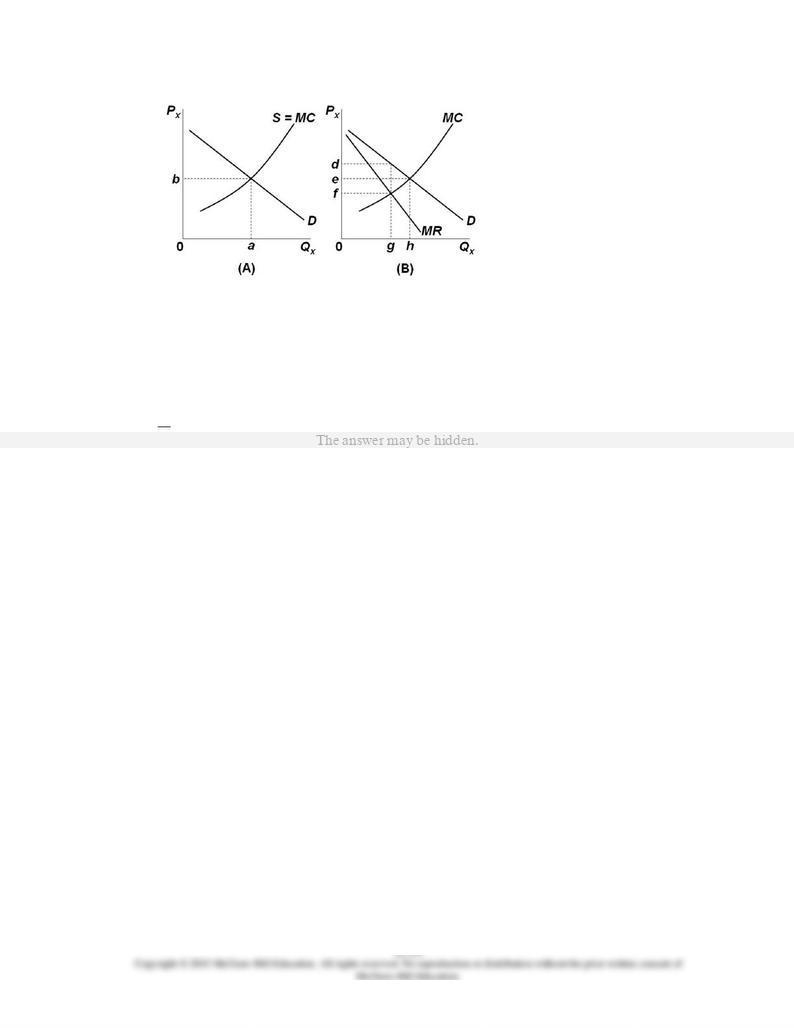
118.
Refer to the diagrams. With the industry structures represented by diagram:
A.
(B) there will be allocative efficiency.
B.
(A) economic profit can persist in the long run.
C.
(B) output will be less than in diagram (A).
AACSB: Reflective Thinking
Blooms: Analyze
Difficulty: 3 Hard
Learning Objective: 12-05 Discuss the economic effects of monopoly.
Topic: Economic effects of monopoly
Type: Graph

119.
Refer to the diagrams. The price will be _______ and the quantity will be _______ with the
industry structure represented by diagram (B) compared to the one represented in (A).
AACSB: Reflective Thinking
Blooms: Analyze
Difficulty: 3 Hard
Learning Objective: 12-05 Discuss the economic effects of monopoly.
Topic: Economic effects of monopoly
Type: Graph
120.
The higher prices charged by monopolists:
AACSB: Analytic
Accessibility: Keyboard Navigation
Blooms: Understand
Difficulty: 2 Medium
Learning Objective: 12-05 Discuss the economic effects of monopoly.
Topic: Economic effects of monopoly

121.
The gains to monopolists from exercising market power:
AACSB: Analytic
Accessibility: Keyboard Navigation
Blooms: Remember
Difficulty: 1 Easy
Learning Objective: 12-05 Discuss the economic effects of monopoly.
Topic: Economic effects of monopoly
122.
X-inefficiency refers to a situation in which a firm:
AACSB: Analytic
Accessibility: Keyboard Navigation
Blooms: Remember
Difficulty: 1 Easy
Learning Objective: 12-05 Discuss the economic effects of monopoly.
Topic: Economic effects of monopoly
123.
Which of the following is not a possible source of natural monopoly?
AACSB: Analytic

Accessibility: Keyboard Navigation
Blooms: Understand
Difficulty: 2 Medium
Learning Objective: 12-05 Discuss the economic effects of monopoly.
Topic: Economic effects of monopoly
124.
There is some evidence to suggest that X-inefficiency is:
AACSB: Reflective Thinking
Accessibility: Keyboard Navigation
Blooms: Understand
Difficulty: 2 Medium
Learning Objective: 12-05 Discuss the economic effects of monopoly.
Topic: Economic effects of monopoly
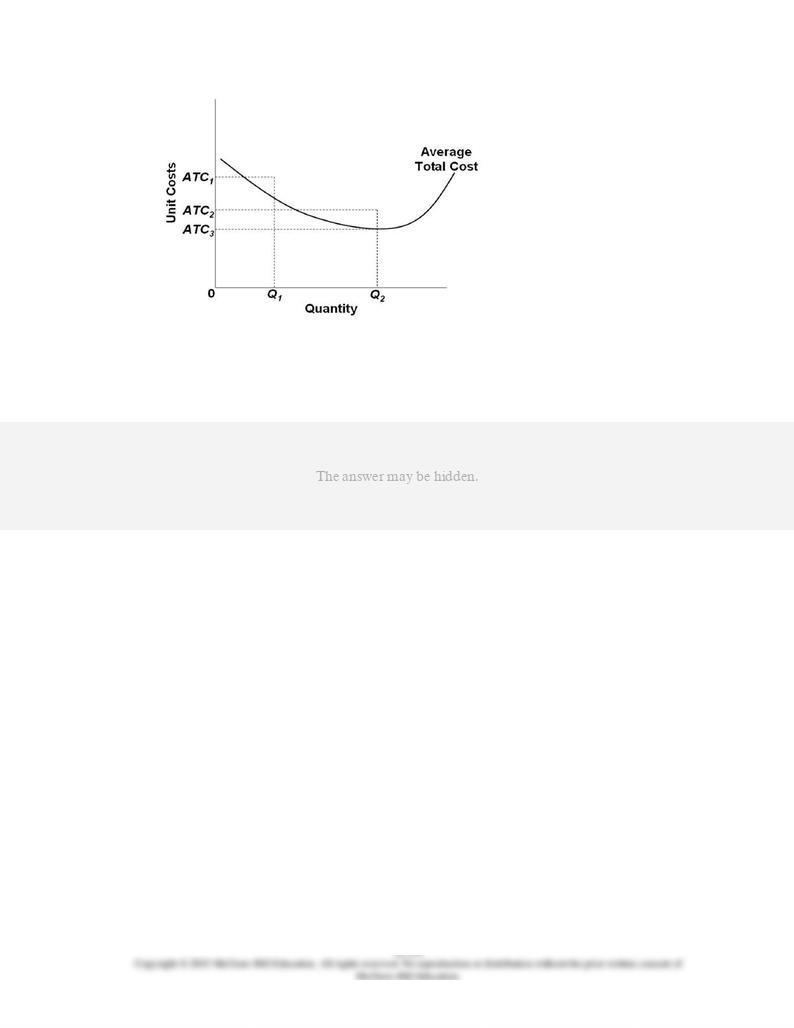
125.
Refer to the long-run cost curve for a firm. If the firm produces output
Q
1 at an average
total cost of ATC1, then the firm is:
AACSB: Reflective Thinking
Blooms: Understand
Difficulty: 2 Medium
Learning Objective: 12-05 Discuss the economic effects of monopoly.
Topic: Economic effects of monopoly
Type: Graph

126.
Refer to the long-run cost diagram for a firm. If the firm produces output
Q
2 at an average
cost of ATC2, then the firm is:
AACSB: Reflective Thinking
Blooms: Understand
Difficulty: 2 Medium
Learning Objective: 12-05 Discuss the economic effects of monopoly.
Topic: Economic effects of monopoly
Type: Graph

127.
Refer to the long-run cost diagram for a firm. If the firm produces output
Q
2 at an average
cost of ATC3, then the firm is:
AACSB: Reflective Thinking
Blooms: Understand
Difficulty: 2 Medium
Learning Objective: 12-05 Discuss the economic effects of monopoly.
Topic: Economic effects of monopoly
Type: Graph
128.
In which one of the following market models is X-inefficiency most likely to be the
greatest?
AACSB: Reflective Thinking
Accessibility: Keyboard Navigation
Blooms: Understand

Difficulty: 2 Medium
Learning Objective: 12-05 Discuss the economic effects of monopoly.
Topic: Economic effects of monopoly
129.
In which one of the following market models is X-inefficiency least likely to be present?
AACSB: Reflective Thinking
Accessibility: Keyboard Navigation
Blooms: Understand
Difficulty: 2 Medium
Learning Objective: 12-05 Discuss the economic effects of monopoly.
Topic: Economic effects of monopoly
130.
Price discrimination refers to:
AACSB: Analytic
Accessibility: Keyboard Navigation
Blooms: Remember
Difficulty: 1 Easy
Learning Objective: 12-06 Describe why a monopolist might prefer to charge different prices in different markets.
Topic: Price discrimination

131.
Which of the following conditions is
not
required for price discrimination?
AACSB: Analytic
Accessibility: Keyboard Navigation
Blooms: Understand
Difficulty: 2 Medium
Learning Objective: 12-06 Describe why a monopolist might prefer to charge different prices in different markets.
Topic: Price discrimination
132.
The practice of price discrimination is associated with pure monopoly because:
AACSB: Reflective Thinking
Accessibility: Keyboard Navigation
Blooms: Understand
Difficulty: 2 Medium
Learning Objective: 12-06 Describe why a monopolist might prefer to charge different prices in different markets.
Topic: Price discrimination
133.
Which of the following is
not
a precondition for price discrimination?
AACSB: Analytic

Accessibility: Keyboard Navigation
Blooms: Understand
Difficulty: 2 Medium
Learning Objective: 12-06 Describe why a monopolist might prefer to charge different prices in different markets.
Topic: Price discrimination
134.
A price discriminating pure monopolist will attempt to charge each buyer (or group of
buyers):
AACSB: Reflective Thinking
Accessibility: Keyboard Navigation
Blooms: Understand
Difficulty: 2 Medium
Learning Objective: 12-06 Describe why a monopolist might prefer to charge different prices in different markets.
Topic: Price discrimination
135.
Other things equal, in which of the following cases would economic profit be the greatest?
AACSB: Reflective Thinking
Accessibility: Keyboard Navigation
Blooms: Analyze
Difficulty: 3 Hard
Learning Objective: 12-06 Describe why a monopolist might prefer to charge different prices in different markets.
Topic: Price discrimination

136.
If a pure monopolist can price discriminate by separating buyers into two or more groups:
AACSB: Reflective Thinking
Accessibility: Keyboard Navigation
Blooms: Understand
Difficulty: 2 Medium
Learning Objective: 12-06 Describe why a monopolist might prefer to charge different prices in different markets.
Topic: Price discrimination
137.
If a monopolist engages in price discrimination, it will:
AACSB: Reflective Thinking
Accessibility: Keyboard Navigation
Blooms: Understand
Difficulty: 2 Medium
Learning Objective: 12-06 Describe why a monopolist might prefer to charge different prices in different markets.
Topic: Price discrimination
138.
Price discrimination is:
AACSB: Reflective Thinking

Accessibility: Keyboard Navigation
Blooms: Remember
Difficulty: 1 Easy
Learning Objective: 12-06 Describe why a monopolist might prefer to charge different prices in different markets.
Topic: Price discrimination
139.
Answer the question on the basis of the following information for a pure monopolist:
How many units would the given profit-maximizing nondiscriminating monopolist
produce?
A.
1.
B.
2.
D.
4.
AACSB: Analytic
Blooms: Analyze
Difficulty: 3 Hard
Learning Objective: 12-06 Describe why a monopolist might prefer to charge different prices in different markets.
Topic: Price discrimination
Type: Table

140.
Answer the question on the basis of the following information for a pure monopolist:
The given nondiscriminating monopolist should set its price at:
AACSB: Analytic
Blooms: Analyze
Difficulty: 3 Hard
Learning Objective: 12-06 Describe why a monopolist might prefer to charge different prices in different markets.
Topic: Price discrimination
Type: Table

141.
Answer the question on the basis of the following information for a pure monopolist:
At its profit-maximizing output, the given nondiscriminating monopolist:
AACSB: Analytic
Blooms: Analyze
Difficulty: 3 Hard
Learning Objective: 12-06 Describe why a monopolist might prefer to charge different prices in different markets.
Topic: Price discrimination
Type: Table

142.
Answer the question on the basis of the following information for a pure monopolist:
If the given profit-maximizing monopolist is able to price discriminate, charging each
customer the price associated with each given level of output, how many units will the firm
produce?
A.
2.
B.
3.
D.
5.
AACSB: Analytic
Blooms: Analyze
Difficulty: 3 Hard
Learning Objective: 12-06 Describe why a monopolist might prefer to charge different prices in different markets.
Topic: Price discrimination
Type: Table
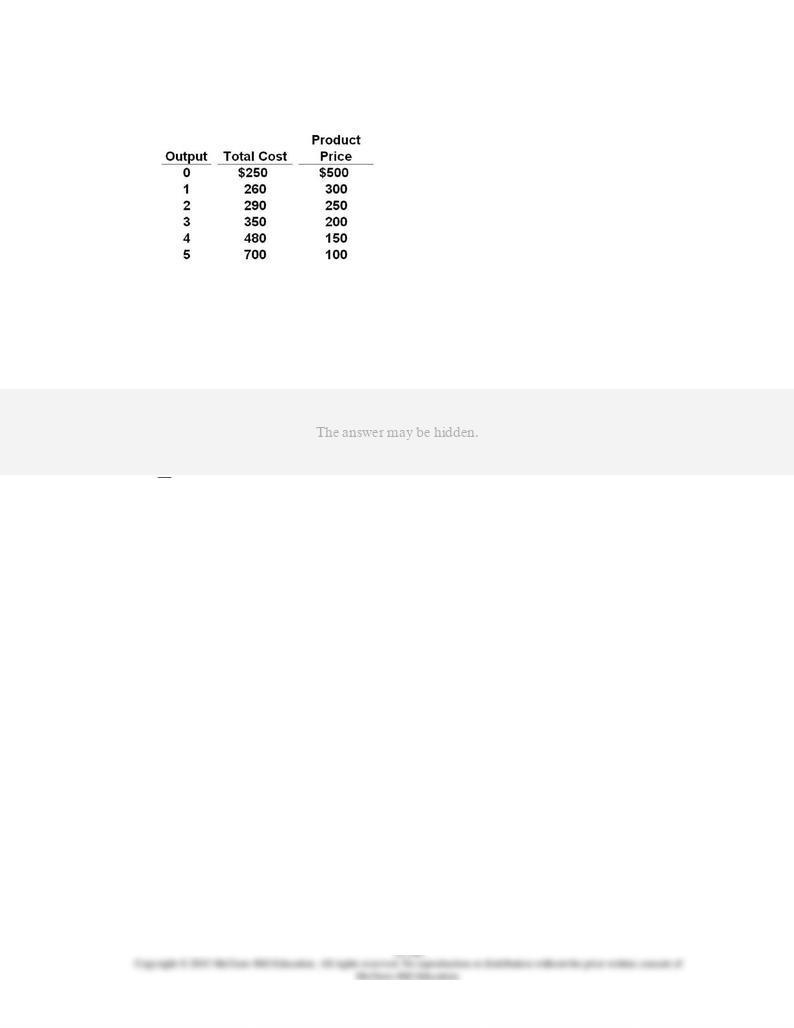
143.
Answer the question on the basis of the following information for a pure monopolist:
If the given profit-maximizing monopolist is able to price discriminate, charging each
customer the price associated with each given level of output, how much profit will the
firm earn?
AACSB: Analytic
Blooms: Analyze
Difficulty: 3 Hard
Learning Objective: 12-06 Describe why a monopolist might prefer to charge different prices in different markets.
Topic: Price discrimination
Type: Table

144.
Refer to the figure. Suppose the graphs represent the demand for use of a local golf
course for which there is no significant competition (it has a local monopoly);
P
denotes
the price of a round of golf;
Q
is the quantity of rounds "sold" each day. If the left graph
represents the demand during weekdays and the right graph the weekend demand, this
profit-maximizing golf course should:
AACSB: Analytic
Blooms: Analyze
Difficulty: 3 Hard
Learning Objective: 12-06 Describe why a monopolist might prefer to charge different prices in different markets.
Topic: Price discrimination
Type: Graph
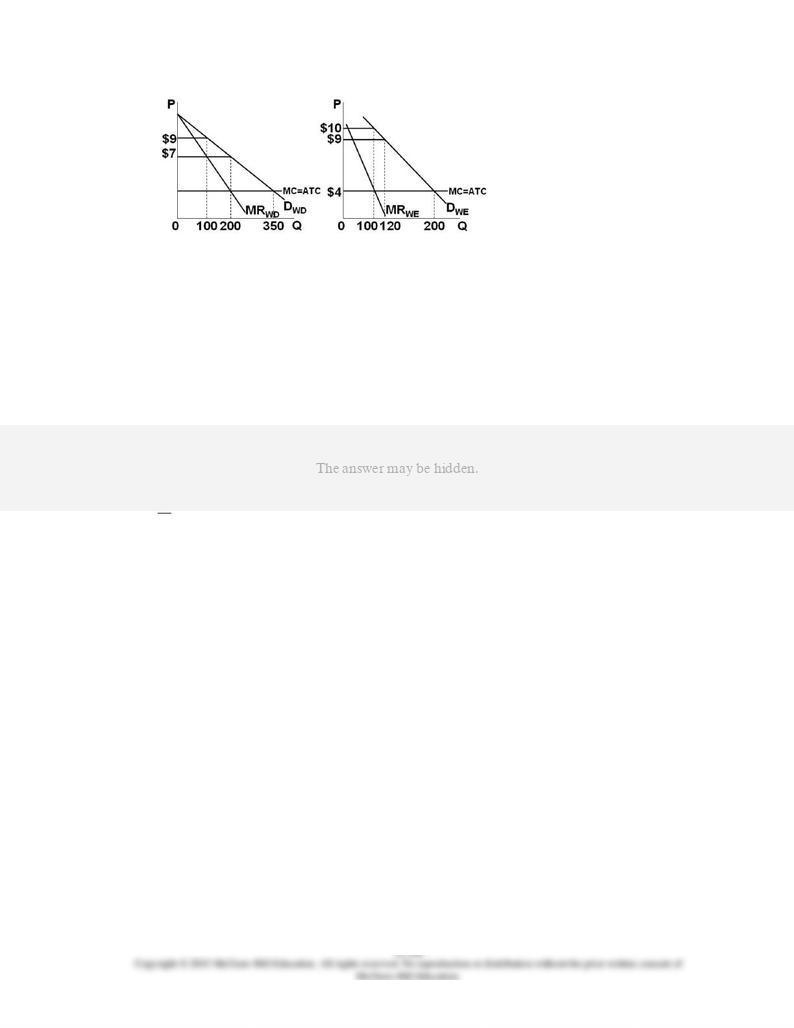
145.
Refer to the figure. Suppose the graphs represent the demand for use of a local golf
course for which there is no significant competition (it has a local monopoly);
P
denotes
the price of a round of golf;
Q
is the quantity of rounds "sold" each day. If the left graph
represents the demand during weekdays and the right graph the weekend demand, then
over the course of a full seven-day week this price-discriminating, profit-maximizing golf
course should sell a total of:
AACSB: Analytic
Blooms: Analyze
Difficulty: 3 Hard
Learning Objective: 12-06 Describe why a monopolist might prefer to charge different prices in different markets.
Topic: Price discrimination
Type: Graph

146.
Refer to the figure. Suppose the graphs represent the demand for use of a local golf
course for which there is no significant competition (it has a local monopoly);
P
denotes
the price of a round of golf;
Q
is the quantity of rounds "sold" each day. If the left graph
represents the demand during weekdays and the right graph the weekend demand, this
profit-maximizing golf course will earn how much economic profit over the course of a full
seven-day week?
AACSB: Analytic
Blooms: Analyze
Difficulty: 3 Hard
Learning Objective: 12-06 Describe why a monopolist might prefer to charge different prices in different markets.
Topic: Price discrimination
Type: Graph

147.
Assume the figure applies to a pure monopolist and that MC is the same for both graphs.
If this firm is able to price discriminate between children and adults, it should charge
prices of:
AACSB: Reflective Thinking
Blooms: Analyze
Difficulty: 3 Hard
Learning Objective: 12-06 Describe why a monopolist might prefer to charge different prices in different markets.
Topic: Price discrimination
Type: Graph

148.
Assume the figure applies to a pure monopolist and that MC is the same for both graphs.
If this firm is able to price discriminate between children and adults, its profit-maximizing
level of output will be:
1C +
2.
1A +
2.
1A +
1C +
2.
AACSB: Reflective Thinking
Blooms: Analyze
Difficulty: 3 Hard
Learning Objective: 12-06 Describe why a monopolist might prefer to charge different prices in different markets.
Topic: Price discrimination
Type: Graph
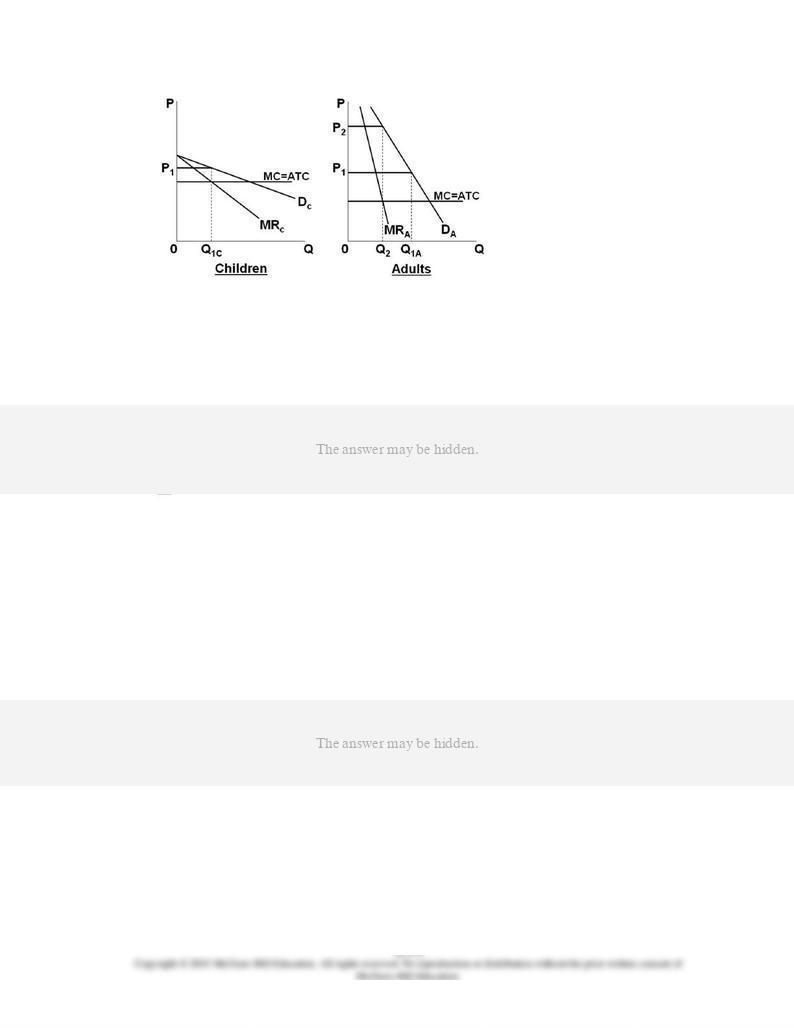
149.
Assume the figure applies to a pure monopolist and that MC is the same for both graphs.
If this firm is able to price discriminate between children and adults, its economic profit
will be:
AACSB: Analytic
Blooms: Analyze
Difficulty: 3 Hard
Learning Objective: 12-06 Describe why a monopolist might prefer to charge different prices in different markets.
Topic: Price discrimination
Type: Graph
150.
Other things equal, a price discriminating monopolist will:
AACSB: Reflective Thinking
Accessibility: Keyboard Navigation
Blooms: Analyze
Difficulty: 3 Hard
Learning Objective: 12-06 Describe why a monopolist might prefer to charge different prices in different markets.
Topic: Price discrimination
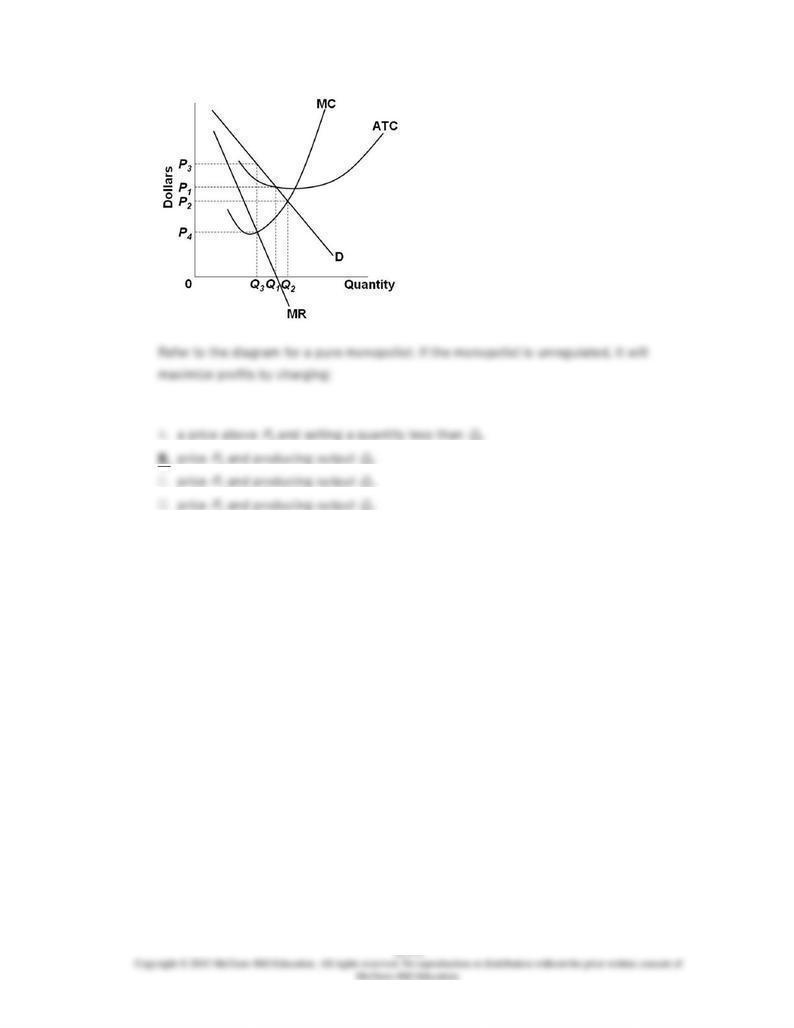
151.
3 and selling a quantity less than
3.
3 and producing output
3.
2 and producing output
2.
1 and producing output
1.
AACSB: Reflective Thinking
Blooms: Analyze
Difficulty: 3 Hard
Learning Objective: 12-07 Distinguish between the monopoly price; the socially optimal price; and the fair-return price of
a government-regulated monopoly.
Topic: Regulated monopoly
Type: Graph

152.
1.
3.
2.
4.
AACSB: Reflective Thinking
Blooms: Apply
Difficulty: 2 Medium
Learning Objective: 12-07 Distinguish between the monopoly price; the socially optimal price; and the fair-return price of
a government-regulated monopoly.
Topic: Regulated monopoly
Type: Graph
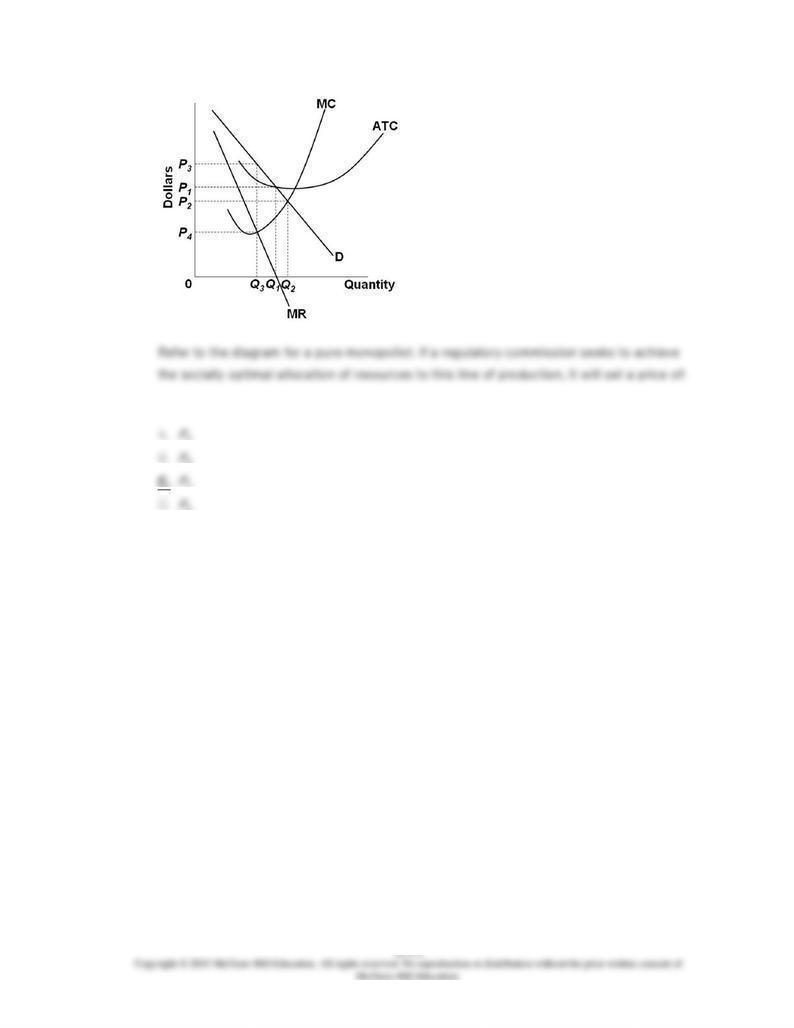
153.
1.
3.
2.
4.
AACSB: Reflective Thinking
Blooms: Apply
Difficulty: 2 Medium
Learning Objective: 12-07 Distinguish between the monopoly price; the socially optimal price; and the fair-return price of
a government-regulated monopoly.
Topic: Regulated monopoly
Type: Graph

154.
Refer to the diagram for a pure monopolist. If a regulatory commission sets the price to
achieve the socially optimal allocation of resources, it will have to:
AACSB: Reflective Thinking
Blooms: Apply
Difficulty: 2 Medium
Learning Objective: 12-07 Distinguish between the monopoly price; the socially optimal price; and the fair-return price of
a government-regulated monopoly.
Topic: Regulated monopoly
Type: Graph

155.
A dilemma of regulation is that:
AACSB: Reflective Thinking
Accessibility: Keyboard Navigation
Blooms: Understand
Difficulty: 2 Medium
Learning Objective: 12-07 Distinguish between the monopoly price; the socially optimal price; and the fair-return price of
a government-regulated monopoly.
Topic: Regulated monopoly
156.
If a regulatory commission wants to provide a natural monopoly with a fair return, it should
establish a price that is equal to:
AACSB: Analytic
Accessibility: Keyboard Navigation
Blooms: Understand
Difficulty: 2 Medium
Learning Objective: 12-07 Distinguish between the monopoly price; the socially optimal price; and the fair-return price of
a government-regulated monopoly.
Topic: Regulated monopoly

157.
If a regulatory commission wants to establish a socially optimal price for a natural
monopoly, it should select a price:
AACSB: Analytic
Accessibility: Keyboard Navigation
Blooms: Understand
Difficulty: 2 Medium
Learning Objective: 12-07 Distinguish between the monopoly price; the socially optimal price; and the fair-return price of
a government-regulated monopoly.
Topic: Regulated monopoly
158.
Suppose for a regulated monopoly that price equals minimum ATC but price exceeds MC.
This means that:
AACSB: Reflective Thinking
Accessibility: Keyboard Navigation
Blooms: Understand
Difficulty: 2 Medium
Learning Objective: 12-07 Distinguish between the monopoly price; the socially optimal price; and the fair-return price of
a government-regulated monopoly.
Topic: Regulated monopoly
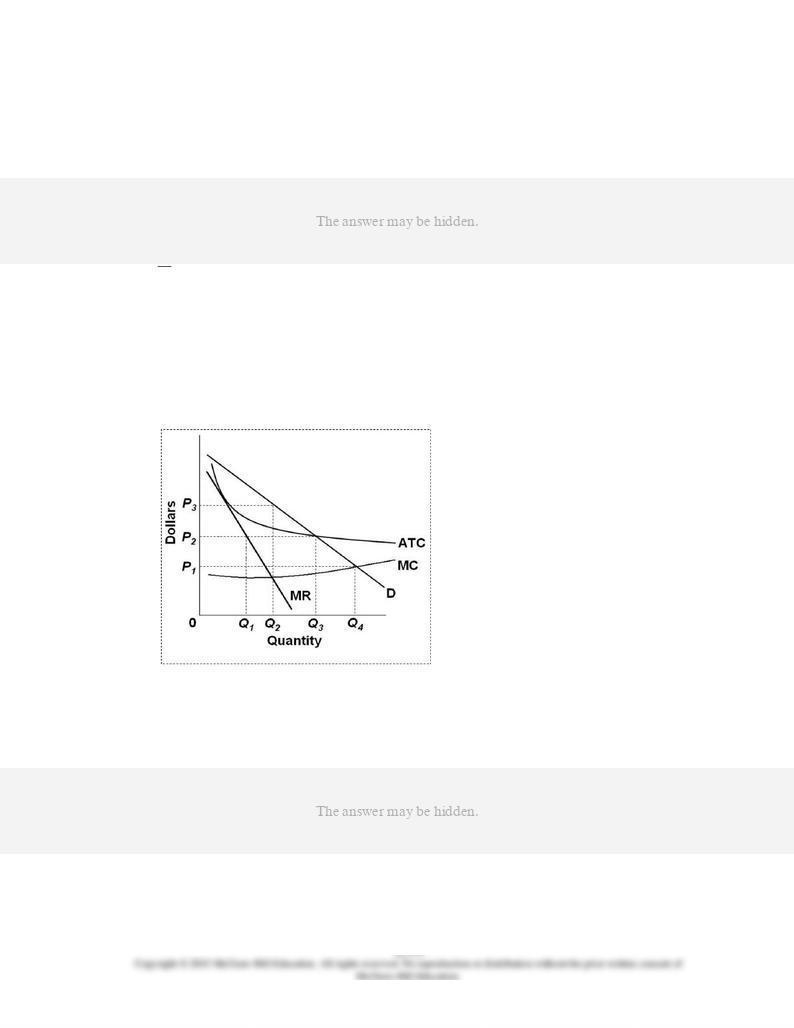
159.
If a regulatory commission imposes upon a nondiscriminating natural monopoly a price
that is equal to marginal cost and below average total cost at the resulting output, then:
AACSB: Reflective Thinking
Accessibility: Keyboard Navigation
Blooms: Understand
Difficulty: 2 Medium
Learning Objective: 12-07 Distinguish between the monopoly price; the socially optimal price; and the fair-return price of
a government-regulated monopoly.
Topic: Regulated monopoly
160.
Refer to the diagram for a natural monopolist. If a regulatory commission were to set a
maximum price of
P
3, the monopolist would:
AACSB: Reflective Thinking
Blooms: Analyze
Difficulty: 3 Hard

Learning Objective: 12-07 Distinguish between the monopoly price; the socially optimal price; and the fair-return price of
a government-regulated monopoly.
Topic: Regulated monopoly
Type: Graph
161.
Refer to the diagram for a natural monopolist. If a regulatory commission set a maximum
price of
P
2, the monopolist would:
AACSB: Reflective Thinking
Blooms: Analyze
Difficulty: 3 Hard
Learning Objective: 12-07 Distinguish between the monopoly price; the socially optimal price; and the fair-return price of
a government-regulated monopoly.
Topic: Regulated monopoly
Type: Graph

162.
Refer to the diagram for a natural monopolist. If a regulatory commission set a maximum
price of
P
1, the monopolist would produce output:
AACSB: Reflective Thinking
Blooms: Analyze
Difficulty: 3 Hard
Learning Objective: 12-07 Distinguish between the monopoly price; the socially optimal price; and the fair-return price of
a government-regulated monopoly.
Topic: Regulated monopoly
Type: Graph

163.
(Consider This) Children are charged less than adults for admission to professional
baseball games but are charged the same prices as adults at the concession stands. This
pricing system occurs because:
AACSB: Reflective Thinking
Accessibility: Keyboard Navigation
Blooms: Apply
Difficulty: 2 Medium
Learning Objective: 12-06 Describe why a monopolist might prefer to charge different prices in different markets.
Topic: Price discrimination
164.
(Consider This) Children are charged less than adults for admission to professional
baseball games but are charged the same prices as adults at the concession stands.
Which of the following conditions of price discrimination explains why this occurs?
AACSB: Analytic
Accessibility: Keyboard Navigation
Blooms: Apply
Difficulty: 2 Medium
Learning Objective: 12-06 Describe why a monopolist might prefer to charge different prices in different markets.
Topic: Price discrimination
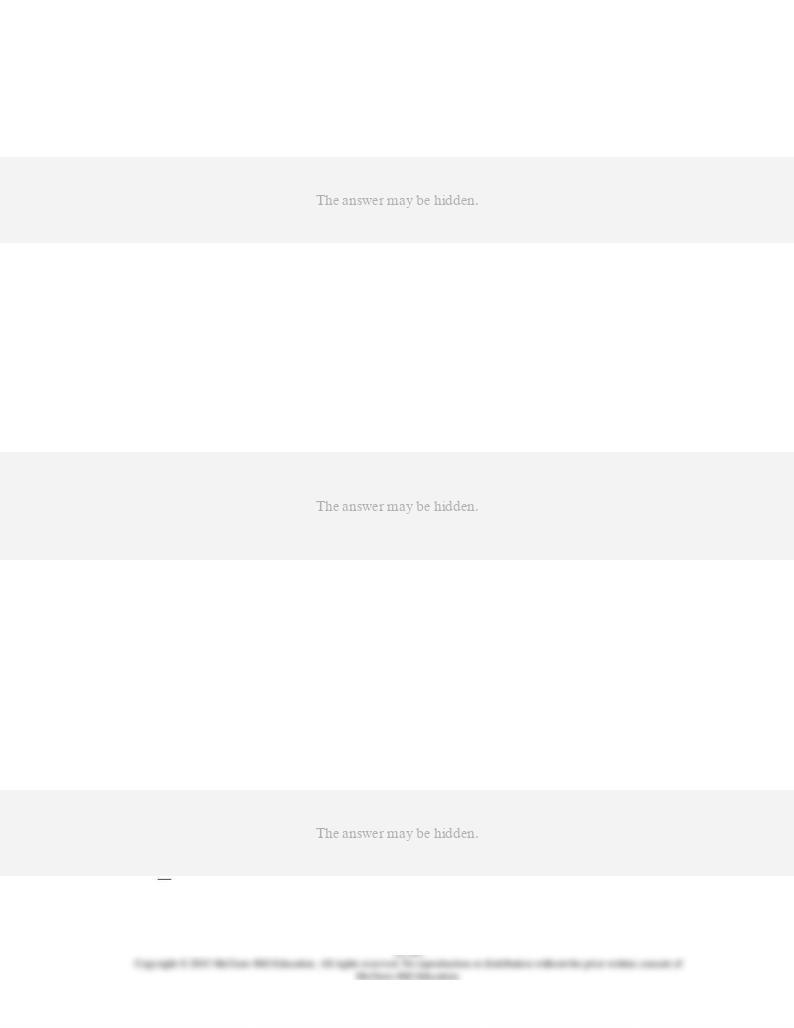
165.
(Last Word) The U.S. Internet search market:
AACSB: Reflective Thinking
Accessibility: Keyboard Navigation
Blooms: Remember
Difficulty: 1 Easy
Learning Objective: 12-02 List and explain the barriers to entry that shield pure monopolies from competition.
Topic: Barriers to entry
166.
(Last Word): Network effects on the Internet:
AACSB: Reflective Thinking
Accessibility: Keyboard Navigation
Blooms: Understand
Difficulty: 2 Medium
Learning Objective: 12-02 List and explain the barriers to entry that shield pure monopolies from competition.
Topic: Barriers to entry
167.
(Last Word): Amazon's rise to become the world's largest online retailer was largely driven
by:
AACSB: Reflective Thinking

Accessibility: Keyboard Navigation
Blooms: Remember
Difficulty: 1 Easy
Learning Objective: 12-02 List and explain the barriers to entry that shield pure monopolies from competition.
Topic: Barriers to entry
True / False Questions
168.
A pure monopolist will maximize profits by producing at that output where price and
marginal cost are equal.
AACSB: Reflective Thinking
Accessibility: Keyboard Navigation
Blooms: Understand
Difficulty: 2 Medium
Learning Objective: 12-04 Explain how a pure monopoly sets its profit-maximizing output and price.
Topic: Output and price determination
169.
In the short run a pure monopolist will maximize profits by producing at that level of output
where the difference between price and average total cost is at a maximum.
AACSB: Reflective Thinking
Accessibility: Keyboard Navigation
Blooms: Understand
Difficulty: 2 Medium
Learning Objective: 12-04 Explain how a pure monopoly sets its profit-maximizing output and price.
Topic: Output and price determination
170.
In the short run a pure monopolist will charge the highest price the market will bear for its
product.
AACSB: Reflective Thinking
Accessibility: Keyboard Navigation
Blooms: Understand

Difficulty: 2 Medium
Learning Objective: 12-04 Explain how a pure monopoly sets its profit-maximizing output and price.
Topic: Output and price determination
171.
Pure monopolists always earn economic profits.
AACSB: Reflective Thinking
Accessibility: Keyboard Navigation
Blooms: Understand
Difficulty: 2 Medium
Learning Objective: 12-04 Explain how a pure monopoly sets its profit-maximizing output and price.
Topic: Output and price determination
172.
If the XYZ Company can sell 4 units per week at $10 per unit and 5 units per week at $9
per unit, the marginal revenue of the fifth unit is $5.
AACSB: Analytic
Accessibility: Keyboard Navigation
Blooms: Apply
Difficulty: 2 Medium
Learning Objective: 12-03 Explain how demand is seen by a pure monopoly.
Topic: Monopoly demand
173.
Because of their large-scale level of production, pure monopolists overallocate resources
to their industry by producing beyond the
P
= MC output.
AACSB: Reflective Thinking
Accessibility: Keyboard Navigation
Blooms: Understand
Difficulty: 2 Medium
Learning Objective: 12-05 Discuss the economic effects of monopoly.
Topic: Economic effects of monopoly

174.
Because of the ability to influence price, a pure monopolist can increase price and
increase volume of sales simultaneously.
AACSB: Reflective Thinking
Accessibility: Keyboard Navigation
Blooms: Understand
Difficulty: 2 Medium
Learning Objective: 12-03 Explain how demand is seen by a pure monopoly.
Topic: Monopoly demand
175.
Refer to the diagrams. Both firms are selling their products in purely competitive markets.
AACSB: Reflective Thinking
Blooms: Understand
Difficulty: 2 Medium
Learning Objective: 12-03 Explain how demand is seen by a pure monopoly.
Topic: Monopoly demand
Type: Graph
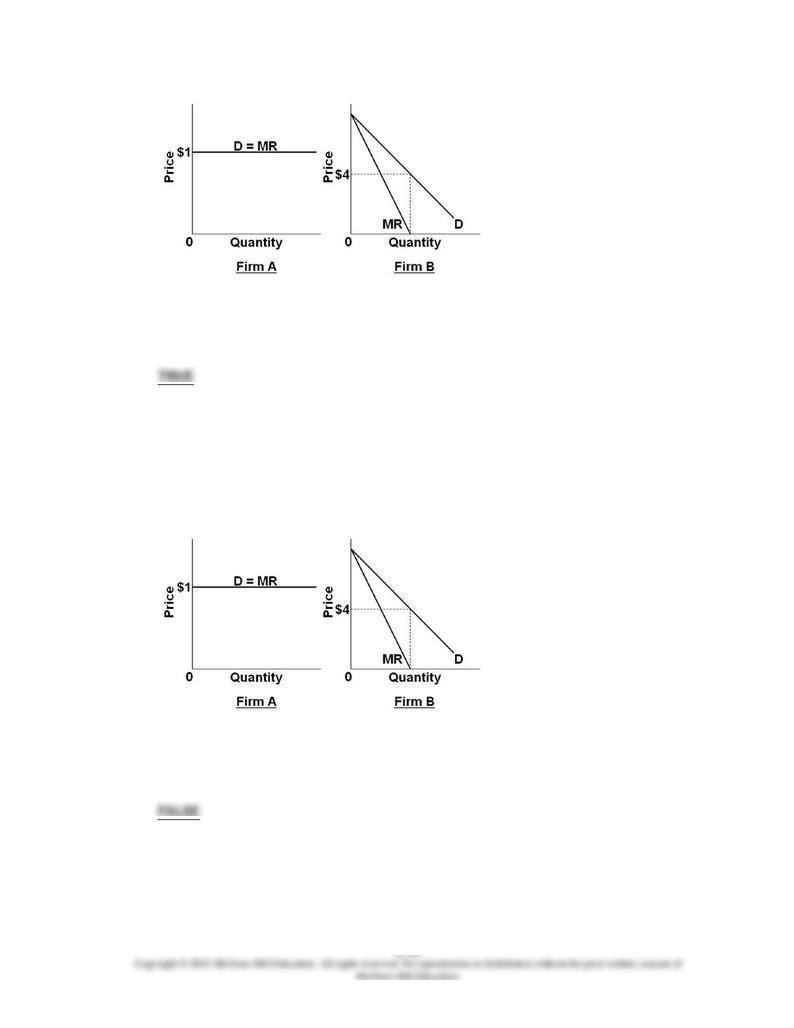
176.
Refer to the diagrams. The demand for Firm B's product is elastic at all prices in excess of
$4.
AACSB: Reflective Thinking
Blooms: Understand
Difficulty: 2 Medium
Learning Objective: 12-03 Explain how demand is seen by a pure monopoly.
Topic: Monopoly demand
Type: Graph
177.
Refer to the diagrams. Firm B's average revenue curve coincides with its marginal revenue
curve.
AACSB: Reflective Thinking
Blooms: Understand
Difficulty: 2 Medium
Learning Objective: 12-03 Explain how demand is seen by a pure monopoly.
Topic: Monopoly demand

Type: Graph
178.
Natural monopoly may result where products produce substantial network effects and can
be simultaneously consumed by a large number of consumers.
AACSB: Analytic
Accessibility: Keyboard Navigation
Blooms: Understand
Difficulty: 2 Medium
Learning Objective: 12-05 Discuss the economic effects of monopoly.
Topic: Economic effects of monopoly
179.
Extensive network effects may drive a market toward natural monopoly because
consumers tend to choose a common, standard product that everyone else is using.
AACSB: Reflective Thinking
Accessibility: Keyboard Navigation
Blooms: Understand
Difficulty: 2 Medium
Learning Objective: 12-05 Discuss the economic effects of monopoly.
Topic: Economic effects of monopoly
180.
Price discrimination occurs whenever a firm sells a good for two different prices.
AACSB: Analytic
Accessibility: Keyboard Navigation
Blooms: Understand
Difficulty: 2 Medium
Learning Objective: 12-06 Describe why a monopolist might prefer to charge different prices in different markets.
Topic: Price discrimination
181.
Price discrimination will result in consumers with more elastic demand purchasing more of
the good than when a single price is charged to all consumers in the market.
AACSB: Reflective Thinking

Accessibility: Keyboard Navigation
Blooms: Understand
Difficulty: 2 Medium
Learning Objective: 12-06 Describe why a monopolist might prefer to charge different prices in different markets.
Topic: Price discrimination
182.
Successful price discrimination requires that buyers charged the different prices be
physically separated.
AACSB: Reflective Thinking
Accessibility: Keyboard Navigation
Blooms: Understand
Difficulty: 2 Medium
Learning Objective: 12-06 Describe why a monopolist might prefer to charge different prices in different markets.
Topic: Price discrimination
183.
Price discrimination is illegal in the United States under antitrust regulations.
AACSB: Reflective Thinking
Accessibility: Keyboard Navigation
Blooms: Remember
Difficulty: 1 Easy
Learning Objective: 12-06 Describe why a monopolist might prefer to charge different prices in different markets.
Topic: Price discrimination
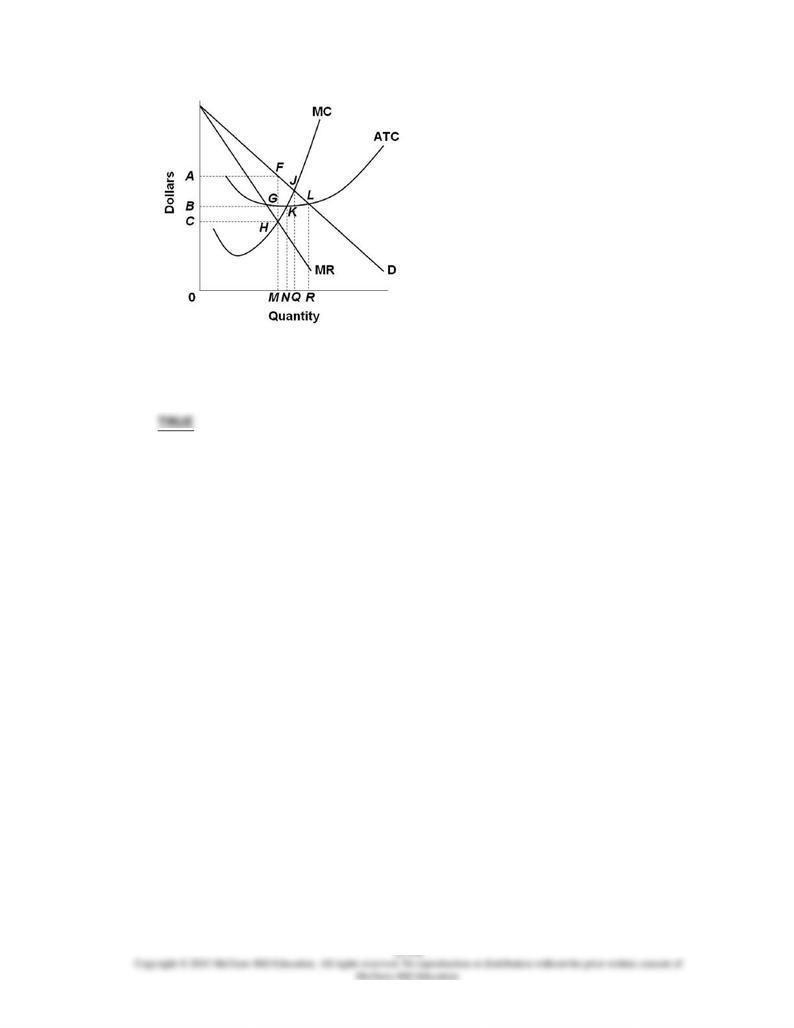
184.
Refer to the diagram for a nondiscriminating monopolist. The profit-maximizing output for
this firm is
M
.
AACSB: Reflective Thinking
Blooms: Analyze
Difficulty: 3 Hard
Learning Objective: 12-04 Explain how a pure monopoly sets its profit-maximizing output and price.
Topic: Output and price determination
Type: Graph
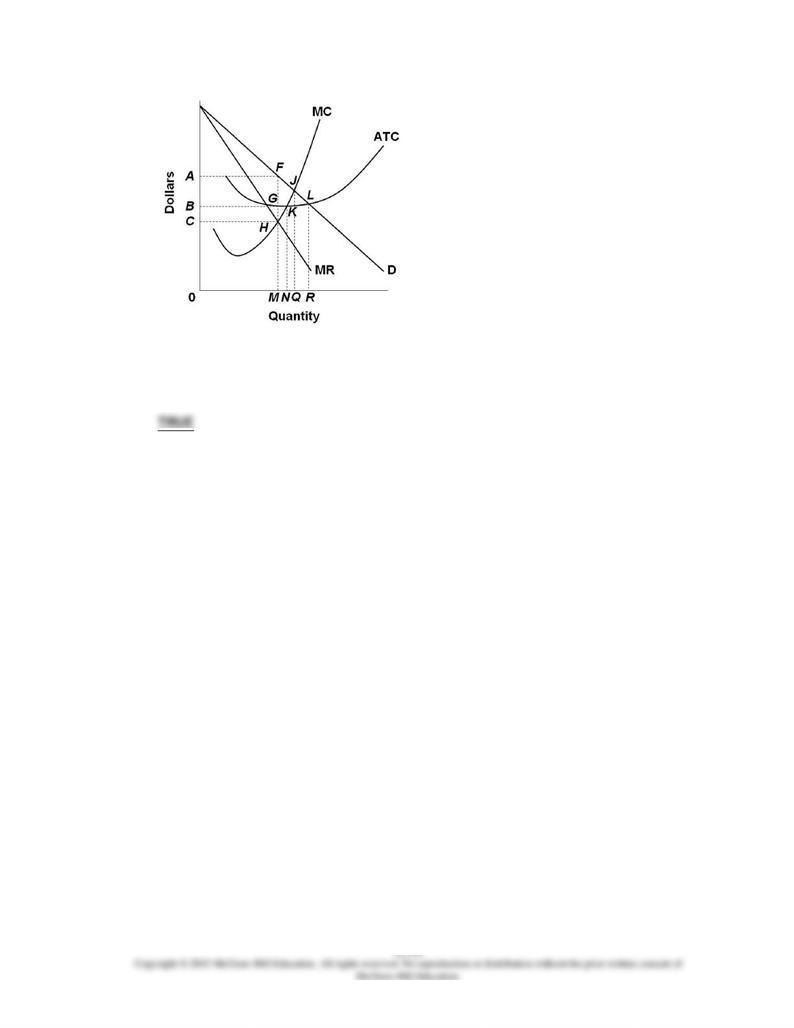
185.
Refer to the diagram for a nondiscriminating monopolist. At the profit-maximizing output
the firm's economic profit will be
BAFG
.
AACSB: Reflective Thinking
Blooms: Analyze
Difficulty: 3 Hard
Learning Objective: 12-04 Explain how a pure monopoly sets its profit-maximizing output and price.
Topic: Output and price determination
Type: Graph
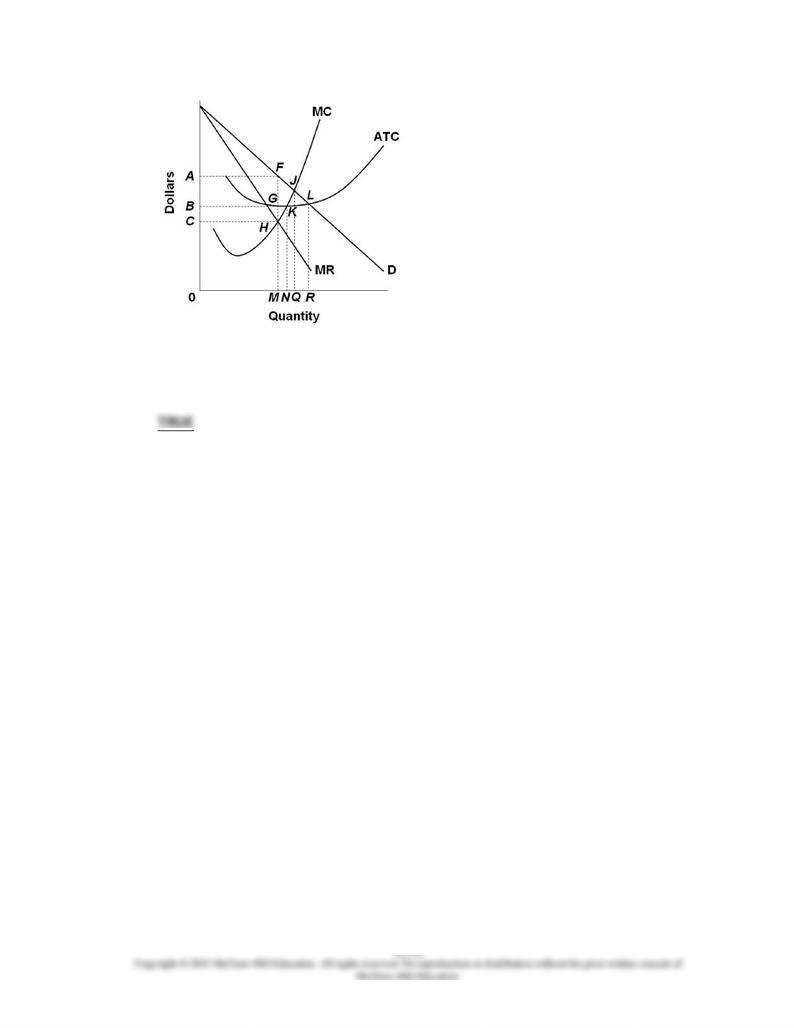
186.
Refer to the diagram for a nondiscriminating monopolist. At output
R
economic profits will
be zero.
AACSB: Reflective Thinking
Blooms: Analyze
Difficulty: 3 Hard
Learning Objective: 12-04 Explain how a pure monopoly sets its profit-maximizing output and price.
Topic: Output and price determination
Type: Graph

187.
Refer to the diagram for a nondiscriminating monopolist. At output
Q
production will be
unprofitable.
AACSB: Reflective Thinking
Blooms: Analyze
Difficulty: 3 Hard
Learning Objective: 12-04 Explain how a pure monopoly sets its profit-maximizing output and price.
Topic: Output and price determination
Type: Graph
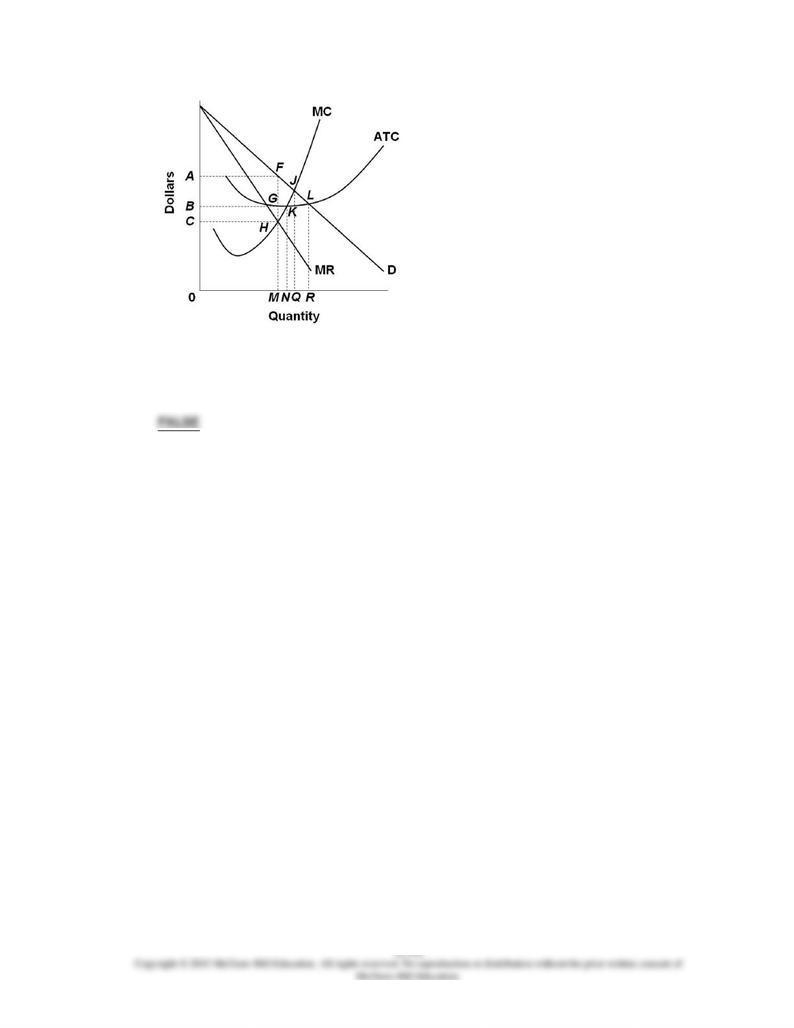
188.
Refer to the diagram for a nondiscriminating monopolist. The profit-maximizing price for
this firm is
J
.
AACSB: Reflective Thinking
Blooms: Analyze
Difficulty: 3 Hard
Learning Objective: 12-04 Explain how a pure monopoly sets its profit-maximizing output and price.
Topic: Output and price determination
Type: Graph
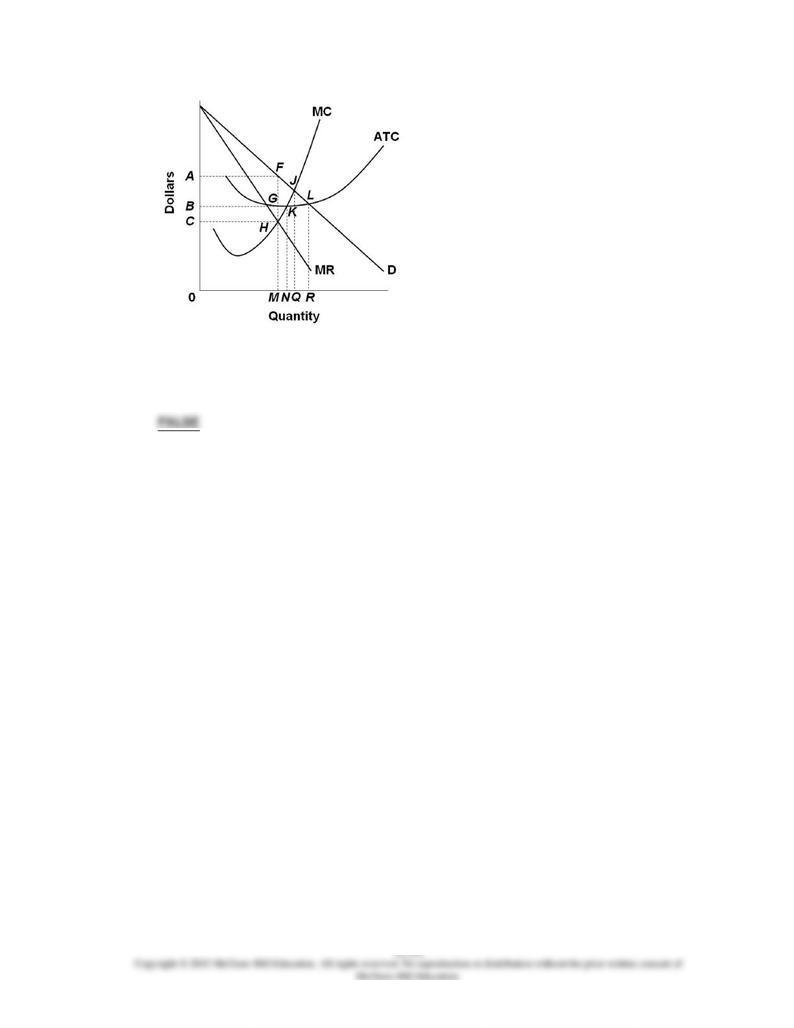
189.
Refer to the diagram for a nondiscriminating monopolist. At output
M
total cost will be
0
CHM
.
AACSB: Reflective Thinking
Blooms: Apply
Difficulty: 2 Medium
Learning Objective: 12-04 Explain how a pure monopoly sets its profit-maximizing output and price.
Topic: Output and price determination
Type: Graph
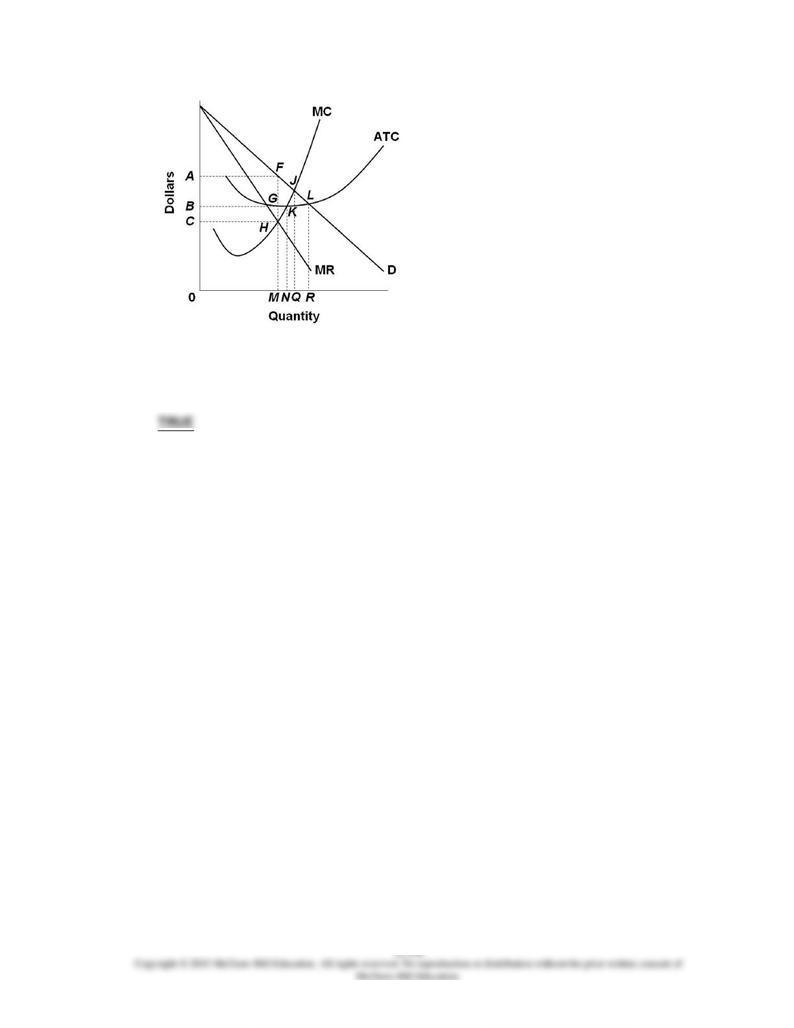
190.
Refer to the diagram for a nondiscriminating monopolist. From society's point of view it
would be desirable to have the monopolist produce a larger output than
M
.
AACSB: Reflective Thinking
Blooms: Analyze
Difficulty: 3 Hard
Learning Objective: 12-07 Distinguish between the monopoly price; the socially optimal price; and the fair-return price of
a government-regulated monopoly.
Topic: Regulated monopoly
Type: Graph
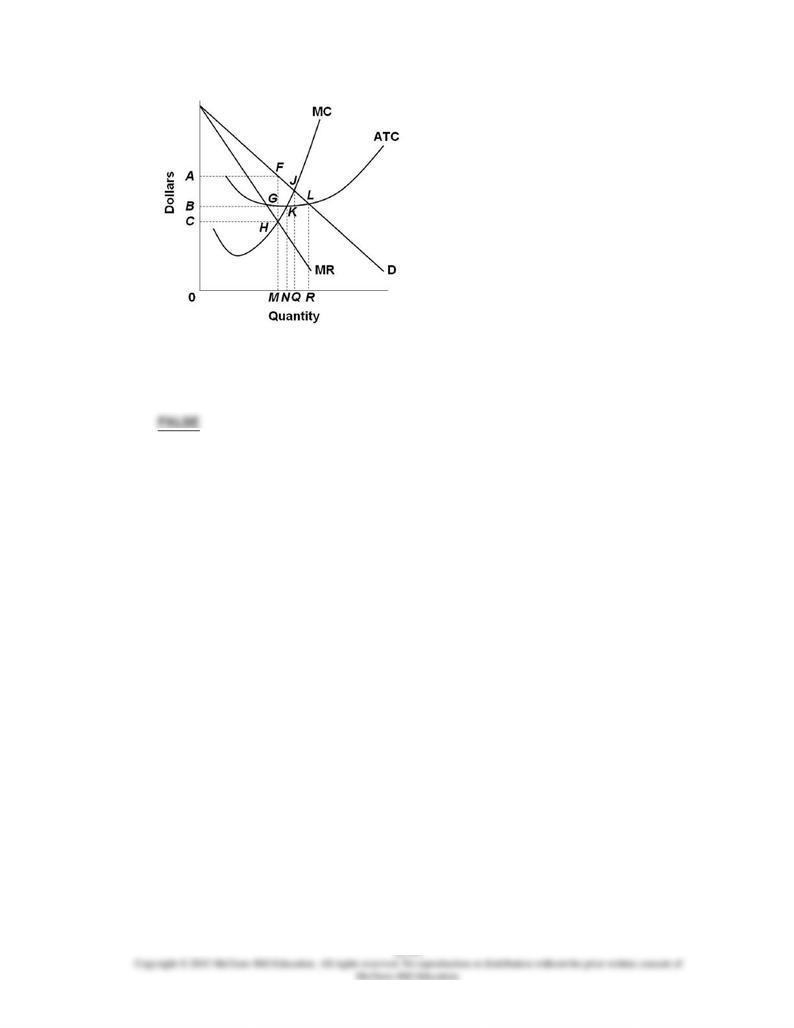
191.
Refer to the diagram for a nondiscriminating monopolist. If the government regulates the
monopolist so that it charges the "fair return" price, the monopolist will produce output
N
.
AACSB: Reflective Thinking
Blooms: Analyze
Difficulty: 3 Hard
Learning Objective: 12-07 Distinguish between the monopoly price; the socially optimal price; and the fair-return price of
a government-regulated monopoly.
Topic: Regulated monopoly
Type: Graph
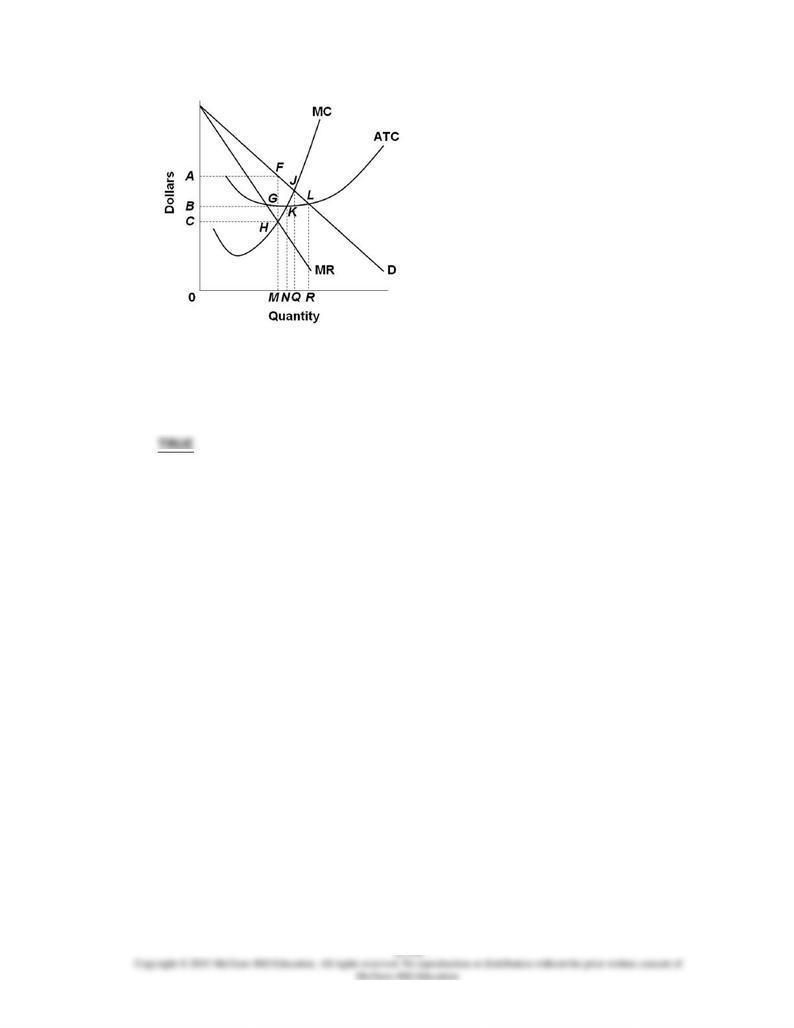
192.
Refer to the diagram for a nondiscriminating monopolist. If the government regulates the
monopolist so that it charges the socially optimal price, the monopolist will produce output
Q
.
AACSB: Reflective Thinking
Blooms: Analyze
Difficulty: 3 Hard
Learning Objective: 12-07 Distinguish between the monopoly price; the socially optimal price; and the fair-return price of
a government-regulated monopoly.
Topic: Regulated monopoly
Type: Graph